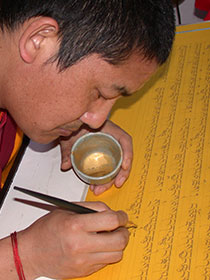- Home
- FPMT Homepage
Foundation for the Preservation of the Mahayana Tradition
The FPMT is an organization devoted to preserving and spreading Mahayana Buddhism worldwide by creating opportunities to listen, reflect, meditate, practice and actualize the unmistaken teachings of the Buddha and based on that experience spreading the Dharma to sentient beings. We provide integrated education through which people’s minds and hearts can be transformed into their highest potential for the benefit of others, inspired by an attitude of universal responsibility and service. We are committed to creating harmonious environments and helping all beings develop their full potential of infinite wisdom and compassion. Our organization is based on the Buddhist tradition of Lama Tsongkhapa of Tibet as taught to us by our founders Lama Thubten Yeshe and Lama Thubten Zopa Rinpoche.
- Willkommen
Die Stiftung zur Erhaltung der Mahayana Tradition (FPMT) ist eine Organisation, die sich weltweit für die Erhaltung und Verbreitung des Mahayana-Buddhismus einsetzt, indem sie Möglichkeiten schafft, den makellosen Lehren des Buddha zuzuhören, über sie zur reflektieren und zu meditieren und auf der Grundlage dieser Erfahrung das Dharma unter den Lebewesen zu verbreiten.
Wir bieten integrierte Schulungswege an, durch denen der Geist und das Herz der Menschen in ihr höchstes Potential verwandelt werden zum Wohl der anderen – inspiriert durch eine Haltung der universellen Verantwortung und dem Wunsch zu dienen. Wir haben uns verpflichtet, harmonische Umgebungen zu schaffen und allen Wesen zu helfen, ihr volles Potenzial unendlicher Weisheit und grenzenlosen Mitgefühls zu verwirklichen.
Unsere Organisation basiert auf der buddhistischen Tradition von Lama Tsongkhapa von Tibet, so wie sie uns von unseren Gründern Lama Thubten Yeshe und Lama Thubten Zopa Rinpoche gelehrt wird.
- Bienvenidos
La Fundación para la preservación de la tradición Mahayana (FPMT) es una organización que se dedica a preservar y difundir el budismo Mahayana en todo el mundo, creando oportunidades para escuchar, reflexionar, meditar, practicar y actualizar las enseñanzas inconfundibles de Buda y en base a esa experiencia difundir el Dharma a los seres.
Proporcionamos una educación integrada a través de la cual las mentes y los corazones de las personas se pueden transformar en su mayor potencial para el beneficio de los demás, inspirados por una actitud de responsabilidad y servicio universales. Estamos comprometidos a crear ambientes armoniosos y ayudar a todos los seres a desarrollar todo su potencial de infinita sabiduría y compasión.
Nuestra organización se basa en la tradición budista de Lama Tsongkhapa del Tíbet como nos lo enseñaron nuestros fundadores Lama Thubten Yeshe y Lama Zopa Rinpoche.
A continuación puede ver una lista de los centros y sus páginas web en su lengua preferida.
- Bienvenue
L’organisation de la FPMT a pour vocation la préservation et la diffusion du bouddhisme du mahayana dans le monde entier. Elle offre l’opportunité d’écouter, de réfléchir, de méditer, de pratiquer et de réaliser les enseignements excellents du Bouddha, pour ensuite transmettre le Dharma à tous les êtres. Nous proposons une formation intégrée grâce à laquelle le cœur et l’esprit de chacun peuvent accomplir leur potentiel le plus élevé pour le bien d’autrui, inspirés par le sens du service et une responsabilité universelle. Nous nous engageons à créer un environnement harmonieux et à aider tous les êtres à épanouir leur potentiel illimité de compassion et de sagesse. Notre organisation s’appuie sur la tradition guéloukpa de Lama Tsongkhapa du Tibet, telle qu’elle a été enseignée par nos fondateurs Lama Thoubtèn Yéshé et Lama Zopa Rinpoché.
Visitez le site de notre Editions Mahayana pour les traductions, conseils et nouvelles du Bureau international en français.
Voici une liste de centres et de leurs sites dans votre langue préférée
- Benvenuto
L’FPMT è un organizzazione il cui scopo è preservare e diffondere il Buddhismo Mahayana nel mondo, creando occasioni di ascolto, riflessione, meditazione e pratica dei perfetti insegnamenti del Buddha, al fine di attualizzare e diffondere il Dharma fra tutti gli esseri senzienti.
Offriamo un’educazione integrata, che può trasformare la mente e i cuori delle persone nel loro massimo potenziale, per il beneficio di tutti gli esseri, ispirati da un’attitudine di responsabilità universale e di servizio.
Il nostro obiettivo è quello di creare contesti armoniosi e aiutare tutti gli esseri a sviluppare in modo completo le proprie potenzialità di infinita saggezza e compassione.
La nostra organizzazione si basa sulla tradizione buddhista di Lama Tsongkhapa del Tibet, così come ci è stata insegnata dai nostri fondatori Lama Thubten Yeshe e Lama Zopa Rinpoche.
Di seguito potete trovare un elenco dei centri e dei loro siti nella lingua da voi prescelta.
- 欢迎 / 歡迎
简体中文
“护持大乘法脉基金会”( 英文简称:FPMT。全名:Foundation for the Preservation of the Mahayana Tradition) 是一个致力于护持和弘扬大乘佛法的国际佛教组织。我们提供听闻,思维,禅修,修行和实证佛陀无误教法的机会,以便让一切众生都能够享受佛法的指引和滋润。
我们全力创造和谐融洽的环境, 为人们提供解行并重的完整佛法教育,以便启发内在的环宇悲心及责任心,并开发内心所蕴藏的巨大潜能 — 无限的智慧与悲心 — 以便利益和服务一切有情。
FPMT的创办人是图腾耶喜喇嘛和喇嘛梭巴仁波切。我们所修习的是由两位上师所教导的,西藏喀巴大师的佛法传承。
繁體中文
護持大乘法脈基金會”( 英文簡稱:FPMT。全名:Found
ation for the Preservation of the Mahayana Tradition ) 是一個致力於護持和弘揚大乘佛法的國際佛教組織。我們提供聽聞, 思維,禪修,修行和實證佛陀無誤教法的機會,以便讓一切眾生都能 夠享受佛法的指引和滋潤。 我們全力創造和諧融洽的環境,
為人們提供解行並重的完整佛法教育,以便啟發內在的環宇悲心及責 任心,並開發內心所蘊藏的巨大潛能 — 無限的智慧與悲心 – – 以便利益和服務一切有情。 FPMT的創辦人是圖騰耶喜喇嘛和喇嘛梭巴仁波切。
我們所修習的是由兩位上師所教導的,西藏喀巴大師的佛法傳承。 察看道场信息:
- FPMT Homepage
- News/Media
-
- Study & Practice
-
-
- About FPMT Education Services
- Latest News
- Programs
- New to Buddhism?
- Buddhist Mind Science: Activating Your Potential
- Heart Advice for Death and Dying
- Discovering Buddhism
- Living in the Path
- Exploring Buddhism
- FPMT Basic Program
- FPMT Masters Program
- FPMT In-Depth Meditation Training
- Maitripa College
- Lotsawa Rinchen Zangpo Translator Program
- Universal Education for Compassion & Wisdom
- Online Learning Center
-
- Prayers & Practice Materials
- Overview of Prayers & Practices
- Full Catalogue of Prayers & Practice Materials
- Explore Popular Topics
- Benefiting Animals
- Chenrezig Resources
- Death & Dying Resources
- Lama Chopa (Guru Puja)
- Lama Zopa Rinpoche: Compendium of Precious Instructions
- Lama Zopa Rinpoche: Life Practice Advice
- Lama Zopa Rinpoche Practice Series
- Lamrim Resources
- Mantras
- Prayer Book Updates
- Purification Practices
- Sutras
- Thought Transformation (Lojong)
- Audio Materials
- Dharma Dates - Tibetan Calendar
- Translation Services
- Publishing Services
- Ways to Offer Support
- Prayers & Practice Materials
-
- Teachings and Advice
- Find Teachings and Advice
- Lama Zopa Rinpoche Advice Page
- Lama Zopa Rinpoche: Compendium of Precious Instructions
- Lama Zopa Rinpoche Video Teachings
- ༧སྐྱབས་རྗེ་བཟོད་པ་རིན་པོ་ཆེ་མཆོག་ནས་སྩལ་བའི་བཀའ་སློབ་བརྙན་འཕྲིན།
- Podcasts
- Lama Yeshe Wisdom Archive
- Buddhism FAQ
- Dharma for Young People
- Resources on Holy Objects
- Teachings and Advice
-
-
*If a menu item has a submenu clicking once will expand the menu clicking twice will open the page.
-
-
- Centers
-
- Teachers
-
- Projects
-
-
-
-
*If a menu item has a submenu clicking once will expand the menu clicking twice will open the page.
-
-
- FPMT
-
-
-
-
-
One of the hallmarks of Buddhism is that you can’t say that everybody should do this, everybody should be like that; it depends on the individual.
Lama Thubten Yeshe
-
-
-
- Shop
-
-
-
The Foundation Store is FPMT’s online shop and features a vast selection of Buddhist study and practice materials written or recommended by our lineage gurus. These items include homestudy programs, prayers and practices in PDF or eBook format, materials for children, and other resources to support practitioners.
Items displayed in the shop are made available for Dharma practice and educational purposes, and never for the purpose of profiting from their sale. Please read FPMT Foundation Store Policy Regarding Dharma Items for more information.
-
-
FPMT Community: Stories & News
7
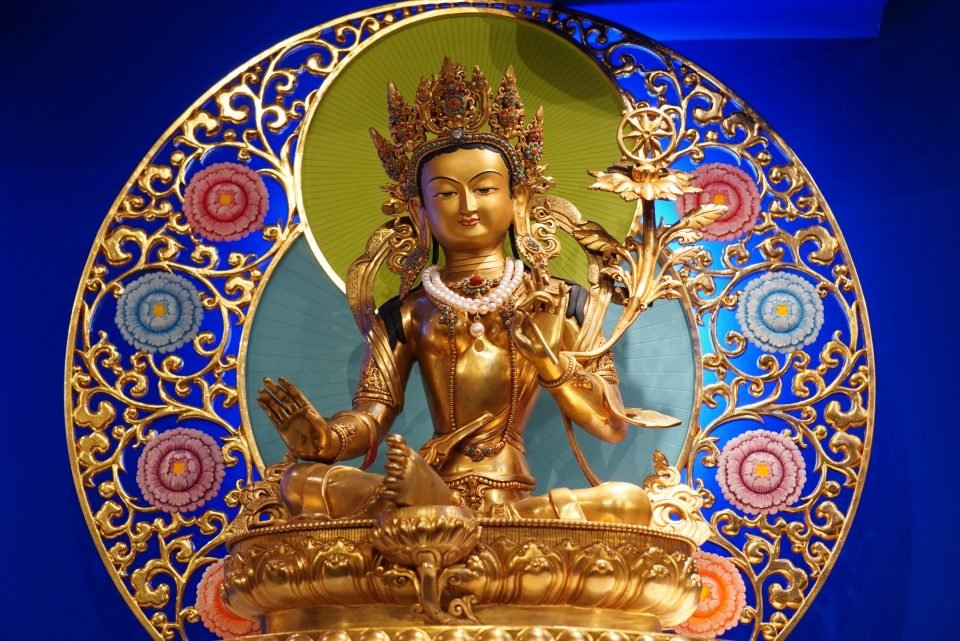
A replica of one of the Twenty-one Tara statues from Rinpoche’s room in Kopan, June 28, 2023, Photo by Venerable Tenzin Tsultrim.
Recently, Amitabha Buddhist Centre (ABC) in Singapore completed an ambitious holy object project advised by Lama Zopa Rinpoche. The project added statues of all the Twenty-one Taras, each standing twenty-four inches high, to the altar in ABC’s beautiful gompa. This was completed in August 2021 and Rinpoche offered a teaching via Zoom during the consecration ceremony in October of that year. This project was recently further enhanced with the completion of an exquisite golden aura adorning each of the statues. ABC Director Tan Hup Cheng shares the story:
The advice to ABC to build the Twenty-one Taras was given by Kyabje Lama Zopa Rinpoche as early as 1995. First, Rinpoche had advised ABC to buy land on which to build a dedicated temple. Secondly, for the main altar, Rinpoche had advised that the central image should be the One-thousand Armed Chenrezig surrounded by the Twenty-one Taras. I wrote down the advice and we designed a graphic of what the altar should look like and showed it to Rinpoche. In this picture, you can see Rinpoche standing next to Lama Osel when he was very young. The central figure of Chenrezig is surrounded by Twenty-one Tara statues together with statues of Shakyamuni Buddha and Lama Tsongkhapa and His Spiritual Sons.
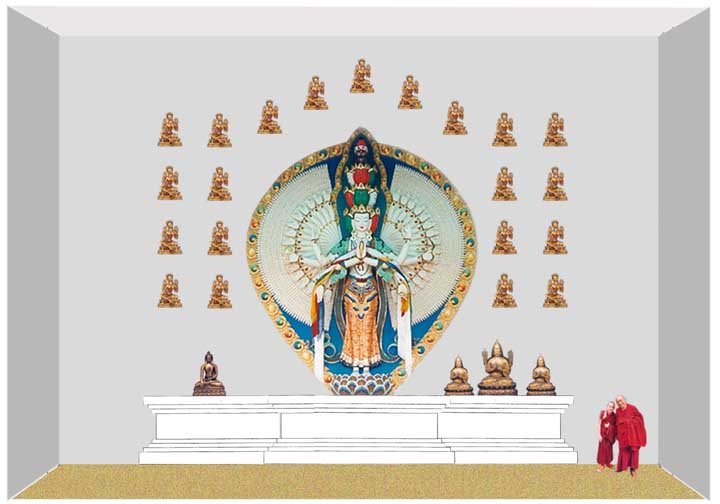
The design of the main altar drawn by Tan Hup Cheng director of ABC Singapore in 2000 based on Rinpoche’s advice.
What was initially an advice given by Rinpoche became the cause for these ideas to develop and finally, be fully actualized. The printout you see here, drawn in 2000, is not far from the reality . As you can see, the marble altar that was a sketch has actually been created. The vision of a One-thousand Arm Chenrezig surrounded by Twenty-one Taras has all been realised. Amazing, amazing, isn’t it, how the words of our guru can be transformed into such a reality?
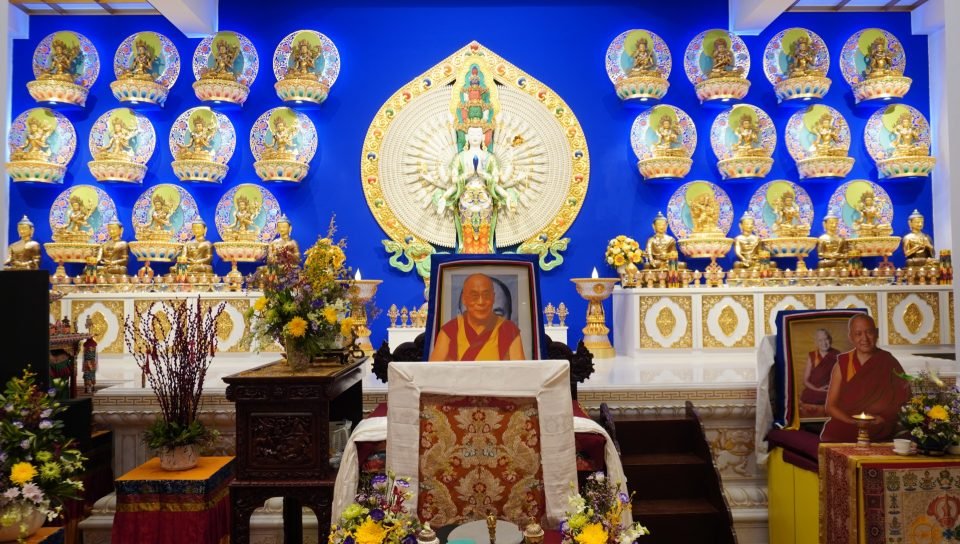
The altar in the main gompa at ABC Singapore, June 28, 2023, Photo by Venerable Tenzin Tsultrim.
Rinpoche had given the advice that the Tara statues for ABC would be a replica of the Twenty-one Taras in his room at Kopan Monastery, 24-inches high, in full gold, in that style. In 2018, we attempted to approach the artist in Nepal who had made that set of Tara statues, but he had passed away. Through the help of Tencho Lama, a Kopan Monk, another statue maker was found and he made a wax model of the 24-inch Tara statue. This was shown to Rinpoche and met his approval. The statue maker then proceeded to cast the full set of Twenty-one Tara statues. In 2020, the pandemic broke out and the production of the statues was delayed. It was not until August 2021, that the statues were completed and shipped to ABC.
To enhance the display of the statues, the artist Peter Griffin had advised that we should adopt a floating display effect of the statues. He proposed to construct the lotus seats for the Tara statues and filigree auras to enhance the statue. We accepted his proposal and he proceeded to construct the lotus seats. To support the lotus seats we had to make a special engineer-designed metal frame secured to the back wall. The background wall was painted with a special “ultramarine blue,” which gave the gold-colored statues a stunning effect. Electrical wiring was laid during the installation. Peter completed the gilded lotus seats and shipped them to Singapore for the consecration in October 2021. Our precious Kyabje Lama Zopa Rinpoche consecrated the statues by Zoom from Kopan Monastery, as we were still in lockdown. It was not until April 2023 that the twenty-one auras were completed and shipped to Singapore. The gilding and painting of the auras was done at ABC and on June 20, 2023 the auras were fully installed with the help of Khen Rinpoche Geshe Chonyi and the Kopan monks.
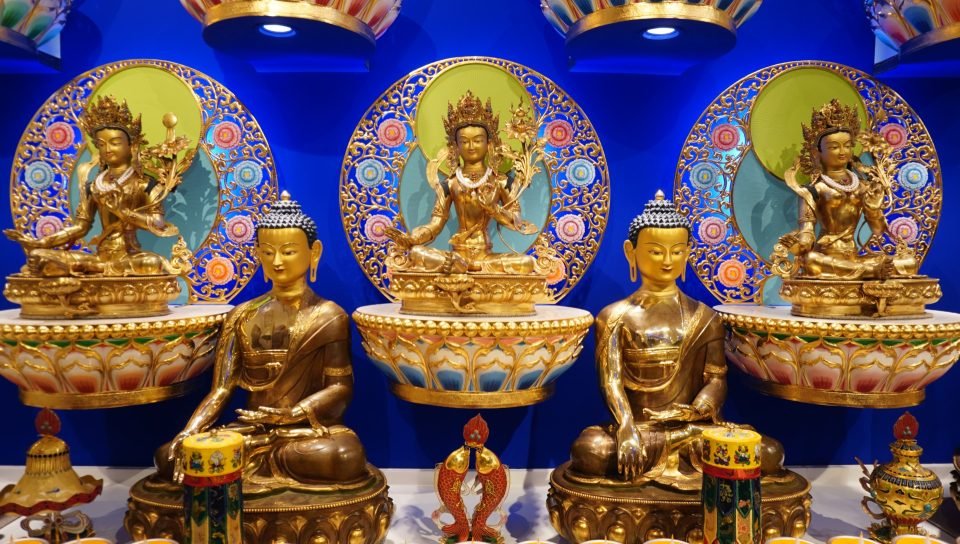
Tara statues on their lotus seats with auras, June 28, 2023, Photo by Venerable Tenzin Tsultrim.
During the journey of making the Twenty-one Taras, which took four years, one very important lesson we learned was to have full faith and trust in the guru’s advice. We adopted a “ Just Do It” mindset, and do whatever it takes to fulfill Rinpoche’s wishes. The result of doing so will be astounding, this project is an example of this.
If FPMT centers or study groups plan to set up a Twenty-one Taras altar, they are welcome to contact ABC Director Tan Hup Cheng for advice.
To help ensure the creation of holy objects around the world as advised by Lama Zopa Rinpoche, all are welcome to offer a donation of any amount to the Holy Objects Fund.
You can learn more about Amitabha Buddhist Centre, Singapore: www.fpmtabc.org
- Tagged: 21 taras, amitabha buddhist centre, holy objects
5
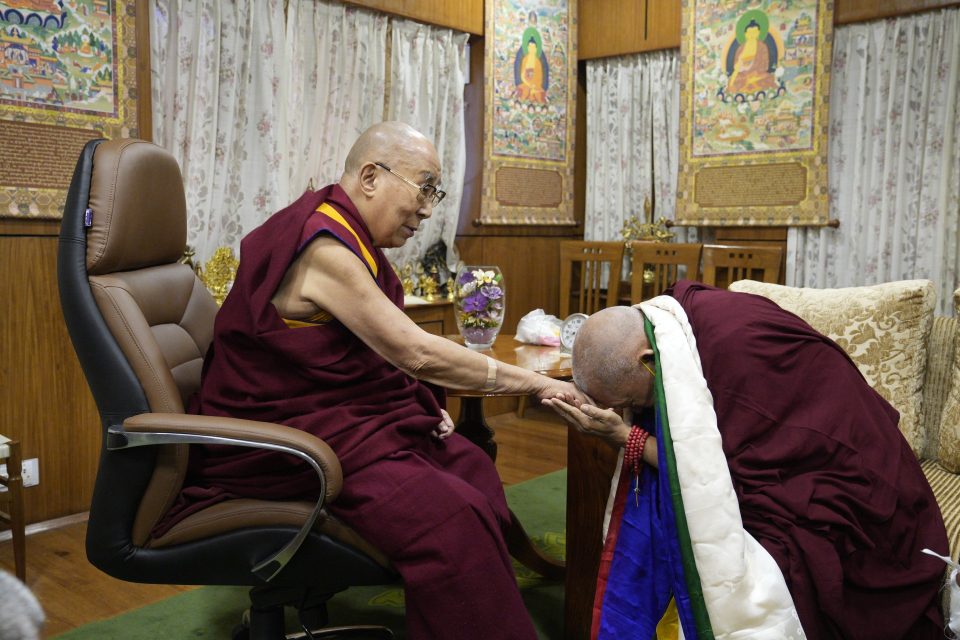
His Holiness meeting with Lama Zopa Rinpoche, Dharamsala, India, November 2, 2022. Photo courtesy of the Office of His Holiness the Dalai Lama.
On July 6, 2023, the world celebrates His Holiness the Dalai Lama’s 88th birthday! We’ve collected several resources for students to use in their celebration of His Holiness and in their ongoing Buddhist study. FPMT International Office wishes His Holiness a very auspicious 88th birthday and sincerely requests His Holiness to live for a very long time and to continue bringing his universal message of compassion to the world.
Great Festival Celebrating His Holiness
Lama Zopa Rinpoche offered extensive advice on prayers and practices to do for His Holiness’s birthday, remarking that by doing these prayers and practices, students also benefit their own Dharma practice. You can find Rinpoche’s collected advice in the booklet How to Do the Great Festival of His Holiness’ Birthday in the Best Possible Way.
Long Life Prayers
The PDF booklet Prayers for the Long Life of His Holiness the Dalai Lama and Tibet contains prayers for the long life of His Holiness the Dalai Lama and for Tibet.
Praises and Requests
“Praises and Requests to His Holiness the Dalai Lama” is a collection of praises of, comments about, and requests for His Holiness by Lama Zopa Rinpoche found in the Lama Yeshe Wisdom Archive Online Advice Book.
Online Teachings by His Holiness
Teachings by His Holiness are usually live streamed, and also available for viewing later as video recordings. The DalaiLama.com also has links to live web streams, scheduled events, summaries of events, and more. Look out for the two teaching events coming up in July, at Leh, Ladakh and Dharamsala, India!
During teachings, His Holiness often conducts the ceremony of generating the awakening mind, where he would urge students to meditate on the two types of bodhicittas. His Holiness himself does the meditation everyday, and he strongly encourages his Dharma friends to likewise do, and put effort into. You will find His Holiness’ typical advice on the practice in the FPMT booklet, The All-Encompassing Yoga Mind Meditation, which is a translation of an oral teaching given by His Holiness in June 2021.
Chenrezig (Avalokiteshvara) Practice Materials
His Holiness is respectfully held as a manifestation of Chenrezig (Avalokiteshvara), the buddha of compassion, by his disciples. At their request, His Holiness had composed these two Chenrezig guru yogas centering on the inseparability of the guru and Chenrezig:
- The Source of All Attainments: The Yoga of the Inseparability of the Guru and Avalokiteshvara – which incorporates the seven-limb practice and requests for blessings from the guru-deity for one to accomplish the path.
- Staircase to Potala Pure Land Guru Yoga – A Practice of Avalokiteśvara – a short Chenrezig guru yoga that references the Compassion Buddha’s pure land, was composed by His Holiness for our ease of practice.
Additional prayers to Chenrezig recommended by Lama Zopa Rinpoche can be found under Chenrezig Practices and Mantras, including the following:
- Request to the Supreme Compassionate One – a request prayer to Chenrezig that Lama Zopa Rinpoche recommended as inspiring and effective. “[This is] a very good prayer, in which you are expressing your mistakes,” Rinpoche explains. “You are trying to practice Dharma with your body, speech, and mind, but when you check, in reality, nothing has become Dharma. Nothing has become pure Dharma because your motivation has always been the eight worldly concerns.” This practice helps you to receive Chenrezig’s guidance, generate compassion for others, and purify heavy negative karma.
To further explore the practice of Chenrezig, visit the FPMT website for more information and materials.
Special Announcement: Today we received the news that His Holiness will visit the Main Tibetan Temple for his 88th birthday celebration on July 6 from around 8:30 a.m. to 10 a.m. where he will give some remarks to the public and view a few cultural presentations before returning to his residence.
Please read a recent statement from FPMT in support of His Holiness the Dalai Lama.
Through comprehensive study programs and practice materials, FPMT Education Services nourishes the development of compassion, wisdom, kindness, and true happiness in individuals of all ages.
- Tagged: his holiness the dalai lama
30
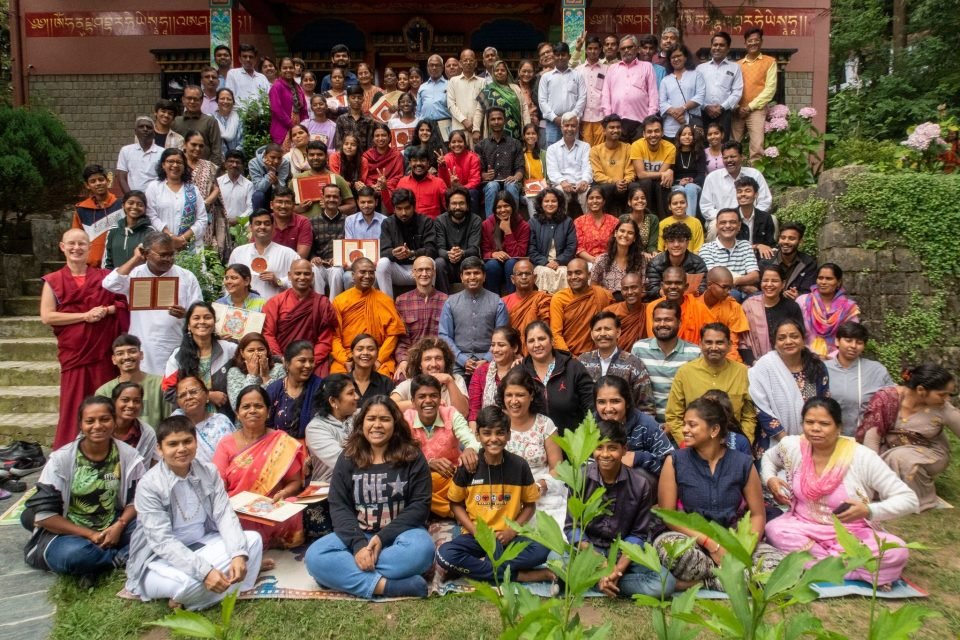
Participants of the first course offered in Hindi at Tushita Meditation Centre, Dharamsala, India. Photo courtesy of Tushita Meditation Centre.
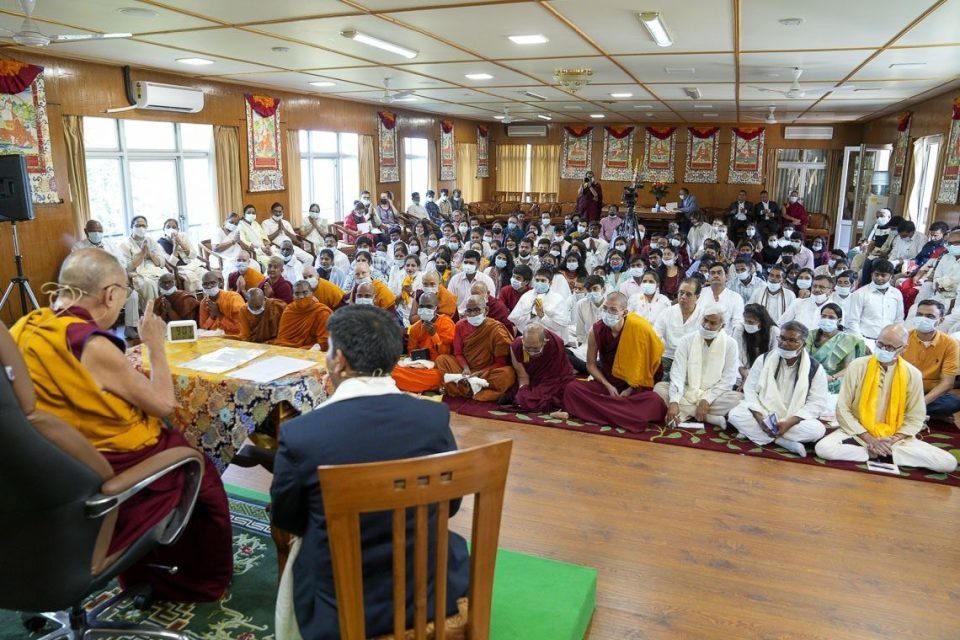
Participants of the Tushita Meditation Centre retreat in Hindi joined the Youth Buddhist Society for a special audience with His Holiness the Dalai Lama at His Holiness’s residence, Dharamsala, India, June 13, 2023. Photo by Ven. Tenzin Jamphel, courtesy of the Office of His Holiness the Dalai Lama.
- Tagged: tushita meditation centre
27
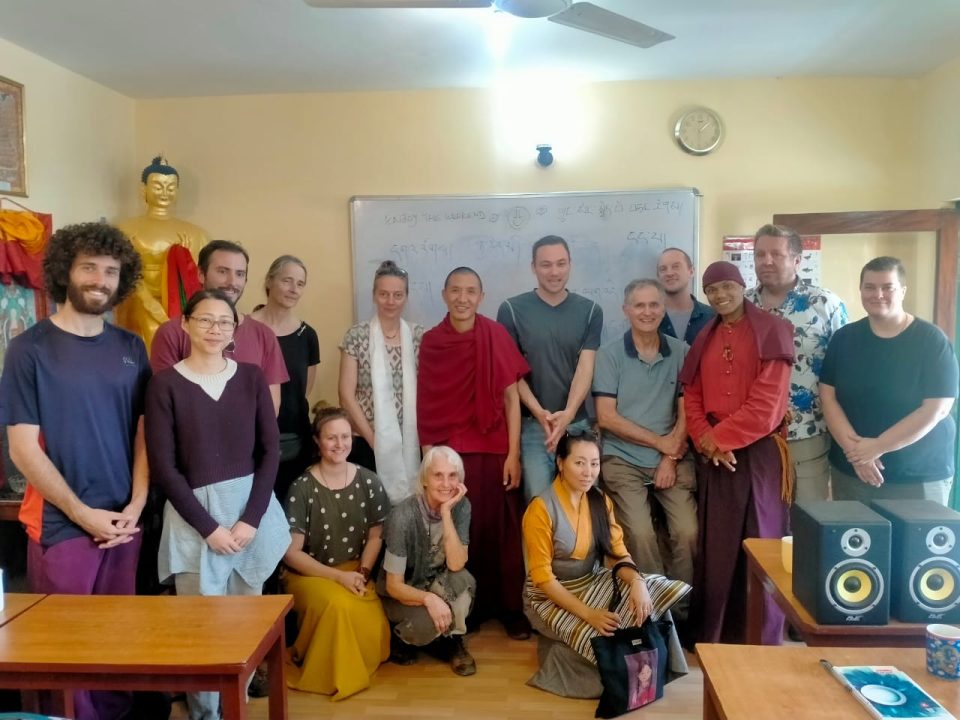
LRZTP 9 started on April 24, 2023. The first two-year course since the pandemic.
Lotsawa Rinchen Zangpo Translator Program (LRZTP), an FPMT project in Dharamsala, Himachal Pradesh, India, had not been able to start a two-year Tibetan language and interpreters training course since the COVID pandemic . We are pleased to report that the new course, LRZTP 9, successfully began on April 24, 2023, with twelve new students. Please rejoice! LRZTP has produced many gifted Dharma interpreters-translators for FPMT Dharma centers since its conception over twenty-two years ago. In addition to the two-year intensive training program, LRZTP also runs short Tibetan language courses and offers private online Tibetan language lessons.
Please read this report from LRZTP about the first two months of the course, and how new students can still join if they have an interest:
It has already been two months since LRZTP 9 started. On April 24 2023 the LRZTP school inaugurated its first two-year intensive course in Dharamsala since the Covid-19 pandemic. With twelve new students the ninth program in the history of the school officially began.
As is always the case, some students already had some background in Tibetan language, with several being actually quite proficient already. Others began learning from scratch. A couple had also attended the online course and one participated in a short beginners’ course in 2019. Regardless of the level at the start of the program, all students have already made a huge progress in Tibetan language over these past two months. They participate in modern Tibetan language classes, have conversation lessons, classical (literary) Tibetan practice as well as cultural presentations.
This study program is quite demanding and the students can feel it especially in the beginning. In particular, the month of May was intense, as apart from regular classes, many guests visited the school and everybody participated in the FPMT Long Life Puja for His Holiness the Dalai Lama. The day after the puja all students joined the FPMT members for an audience with His Holiness in the residence in McLeodganj, receiving blessing and a surprise tea and snacks. This was truly an auspicious occasion, especially for the beginning of the program, an inspiration in studies.
In order to inspire the new students even more several guests visited the school in the month of May. Graduates of the program shared their experiences and gave guidance on how to study and live in Dharamsala. One particularly distinguished graduate was Ven. Kartsön (Yaki Platt), who until recently served as an interpreter at the Chenrezig Institute in Australia. He not only shared his experiences from the time when he was a student, but also talked about the ups and downs of the life of a Buddhist teachings’ interpreter.
Another inspirational guest was Isabelle Henrion-Dourcy, Tibetologist and anthropology professor who studied Tibetan opera in Tibet. Since, contrary to most students of Tibetan language she did not come to learning Tibetan through Buddhism, she could offer yet another perspective on studying the language. Her story was exceptional as she spent much of her time in eastern Tibet and could speak dialects of that area.
One more distinguished guest in May was Ven. Tashi Choedup, coordinator of FPMT India. Tashi was a student of LRZTP in the past but the general discussion between them and the students focused on the problem of translation in a gender neutral way. Tashi talked about how Dharma is (not) translated into modern Indian languages and how difficult it is to make Dharma language fair towards genders. The insensitivity of gender based expressions was a topic of a short debate which followed.
Currently the LRZTP 9 students are already able to express themselves in all three tenses (past, present and future) and can hold conversations about Tibet, their families and countries, weather, food and school. Before the first module ends in mid-July they will also acquire the ability to count in Tibetan, do shopping in Tibetan and make polite requests. They are getting ready for their first attempts in making short translations of scriptures.
And, as we always want to stress, LRZTP is by no means closed to new students just because the ninth program has already begun. In fact, we are happy to announce that in August the current batch will be joined by two new people – from Poland and Sweden. Since they will not be joining the program from the start, they will need to pass an entry exam, which will be the first module final exam. However, since both of them studied before and already attended private classes at LRZTP, this should be a piece of cake for them.
For more information about the Lotsawa Rinchen Zangpo Translator Program in Dharamsala, Himachal Pradesh, India, visit their website: http://www.lrztp.org
23
June 2023 e-News is Now Available!
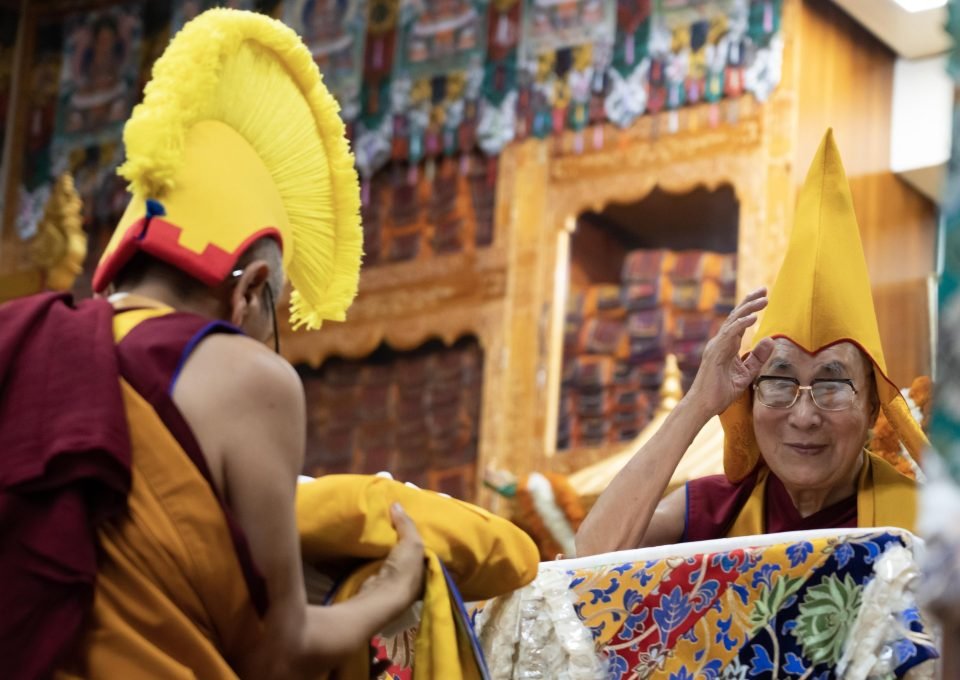
FPMT Board member and Abbot of Kopan Monastery Khenrinpoche Geshe Chonyi making one of the traditional offerings to His Holiness the Dalai Lama during the May 24 long life puja offered on behalf of Lama Zopa Rinpoche and the entire FPMT organization. Photo by Ven. Lobsang Sherab.
This month’s e-news brings you important news, updates, and causes for rejoicing including:
- A moving overview of the long life puja offered to His Holiness the Dalai Lama and accompanying events in Dharamsala
- Prayers and practices done at Kopan Monastery and Lawudo during the 49 days of Rinpoche showing the aspect of passing away.
- Two compositions from Lama Zopa Rinpoche newly available
- Great lamas teaching at FPMT centers in Europe
- Update on the Light of the Path Retreat and Foundation Service Seminar at Kopan
-
News of two FPMT Basic Programs are starting September 2023
An much more!
Please read this month’s e-news in its entirety.
Have the e-News translated into your native language by using our convenient translation facility located on the right-hand side of the page.
Visit our subscribe page to receive the monthly FPMT International Office e-News directly in your email inbox.
- Tagged: fpmt enews
16
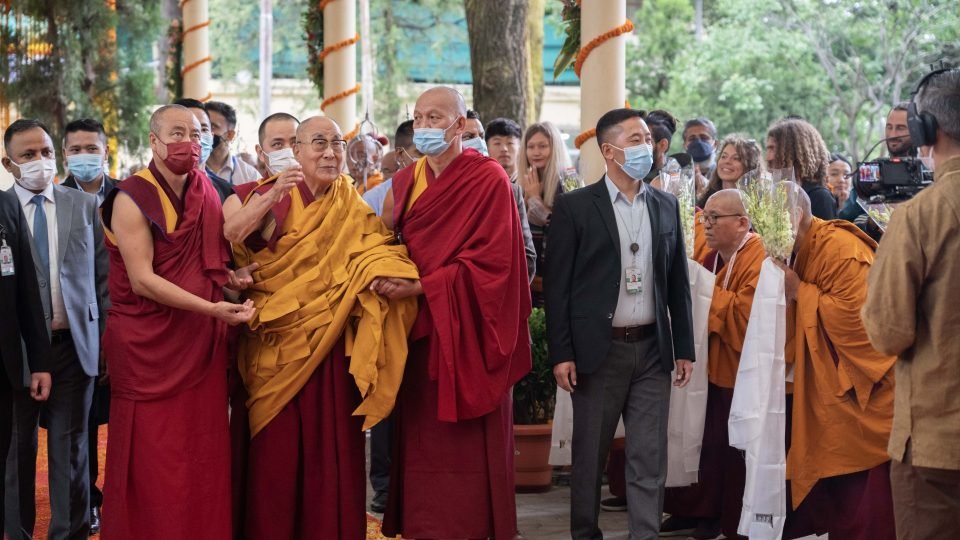
His Holiness the Dalai Lama entering the Main Tibetan Temple for the long life puja offered to him by the FPMT organization, Dharamsala, India, May 24, 2023. Photo by Ven. Lobsang Sherab.
Three hundred and fifty members of the FPMT organization, including 150 who joined the event from abroad, participated in a moving long life puja offered to His Holiness the Dalai Lama in Dharamsala, India, on May 24, 2023. This event was the culmination of months of concentrated effort, and was a sincere request from Lama Zopa Rinpoche that was years in the making. Following the long life puja, a small series of important and auspicious events took place in Dharamsala. Ven. Tenzin Legtsok was in attendance for all of these events and provided a moving overview of the activities and the impact on those in attendance.
Long Life Puja for His Holiness the Dalai Lama
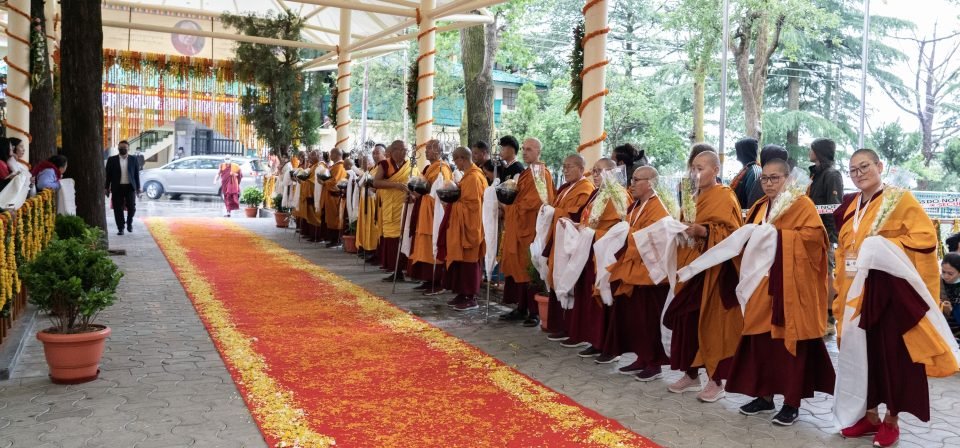
Ven. Tenzin Legtsok (the author of this article, toward the middle of the assembly) joins Kopan monks and nuns waiting for His Holiness the Dalai Lama before the May 24 long life puja. Photo by Ven. Lobsang Sherab.
It is said that among offerings to the guru, the offering of practice is supreme. Last November, His Holiness the Dalai Lama, sole refuge and guide of the world, accepted Kyabje Lama Zopa Rinpoche’s request to offer a long-life puja on behalf of the entire FPMT organization. On May 24, headed by the precious Abbot of Kopan Monastery, Khen Rinpoche Geshe Thubten Chonyi, Ven. Roger Kunsang, the FPMT Board, many tulkus, geshes, geshemas, monks, nuns, and hundreds of students and sponsors from all reaches of the FPMT family came together to fulfill this wish of our inexpressibly kind lama. In this way it was not only an elaborate offering to His Holiness, but also an offering to Kyabje Lama Zopa Rinpoche by working together to fulfill Rinpoche’s holy wishes.
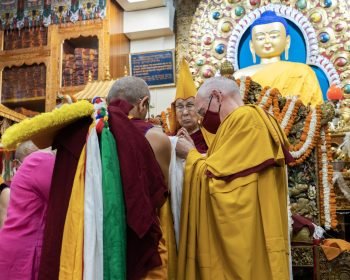
FPMT Board members Paula de Wys, Khenrinpoche Geshe Chonyi, and Ven. Roger Kunsang offering a mandala to HIs Holiness the Dalai Lama, May 24, 2023. Photo by Ven. Lobsang Sherab.
After months of preparation, especially by the staff of International Office and by the Kopan monks and nuns, raising funds, commissioning and filling statues, coordinating with His Holiness’ Private Office, and with all the participants, preparing texts, bringing many offerings from Nepal, everything was nearly ready. On the evening of May 23, the Main Temple was a swarm of activity with passes being distributed, the procession line being organized, tormas being set up, orchids arranged, and many old friends meeting once again. The puja began at six in the morning with preliminary prayers, and tea and bread offered to all in attendance. His Holiness came from his palace gates a little before eight and slowly walked to the Main Temple past a line of FPMT geshes and geshemas standing to receive him, smiling and greeting all in the crowd.
As soon as His Holiness was seated, the Chant Master of Kopan, Geshe Lobsang Sherab, led the entire assembly in reciting Lama Chopa. After tea and sweet rice had been served His Holiness made his only remarks during the ceremony. [Please enjoy this short video including many moving aspects of the long life puja offered to His Holiness which includes translated words shared by His Holiness about Lama Zopa Rinpoche.]
Key points made by His Holiness include:
“These long-life prayers are being offered today by the FPMT, an organization with many centers around the world that has for quite some time been led by the late Zopa Rinpoche. He has been my friend and a very trustworthy person. Recently, he passed away. An excellent reincarnation of his will definitely come. For this to happen I will pray, and I urge all of you, Rinpoche’s acquaintances, to make strong prayers that an excellent reincarnation is able to come. …
“Lama Zopa Rinpoche really made outstanding efforts during his lifetime. Rinpoche himself definitely has strong aspirational prayers for an excellent reincarnation. I also hope that an excellent reincarnation is able to come and I request all of you to pray for this. …
“I am determined to work for the flourishing of the Buddha’s teachings and welfare of all sentient beings, as Je Tsongkhapa wrote in a verse at the end of his Great Treatise on the Stages to the Path to Enlightenment:
Wherever the Buddha’s teaching has not spread
And wherever it has spread but has declined
May I, moved by great compassion, clearly elucidate
This treasury of excellent benefit and happiness for all.”

Tsog offerings in front of the Main Tibetan Temple, Dharamsala, India, May 24, 2023. Tenzin Choejor, courtesy of DalaiLama.com.
In the course of the Lama Chopa, with Khenrinpoche Geshe Chonyi acting as vajra master, FPMT offered a mandala, representations of the enlightened body, speech, and mind, monastic robes, staff, bowl and other monastic articles, the eight auspicious symbols, the seven emblems of royalty, the eight auspicious substances, texts, medicinal powders, carpets, and several hundred of the 1000 Buddha statues.
Dedications were made with the prayers, Prayer for the Flourishing of Je Tsongkhapa’s Teachings, Causing the Teachings of Buddha to Flourish, Prayer for the Spreading of Ecumenical Buddha’s Teachings, and finally concluded with The Prayer of the Words of Truth composed by His Holiness the Dalai Lama.
“So, if these prayers today are effective, everyone will benefit,” His Holiness said. “Tibet and the neighbouring lands of the Himalayan region have a long-standing connection to the Dalai Lamas. I am determined to work for the benefit of the people who live in these places, but in addition there are now scientists across the world who are interested in what the Buddha’s teaching have to say about the workings of the mind and emotions. I would like to help them as much as I can too.
“For these purposes, supported by your prayers and dedication, I feel I may be able to live another twenty years or so. I’m keen to let people, especially those who have no religious allegiance or interest in spiritual affairs, know the importance of cultivating love and compassion and achieving peace of mind.” [This quote is taken from the dalailama.com coverage of the puja].
All in all, the event went very smoothly, the prayers were chanted beautifully, and His Holiness showed the aspect of being pleased with the entire occasion.
Sixth Week Commemoration, Private Audience, and FPMT Lunch
Puja commemorating the sixth week
In addition to offering a long-life puja to His Holiness, all the FPMT students in attendance participated in a puja commemorating the sixth week since Rinpoche showed the aspect of passing away, a private audience with His Holiness on May 25, and an FPMT lunch hosted by Tushita Meditation Center.
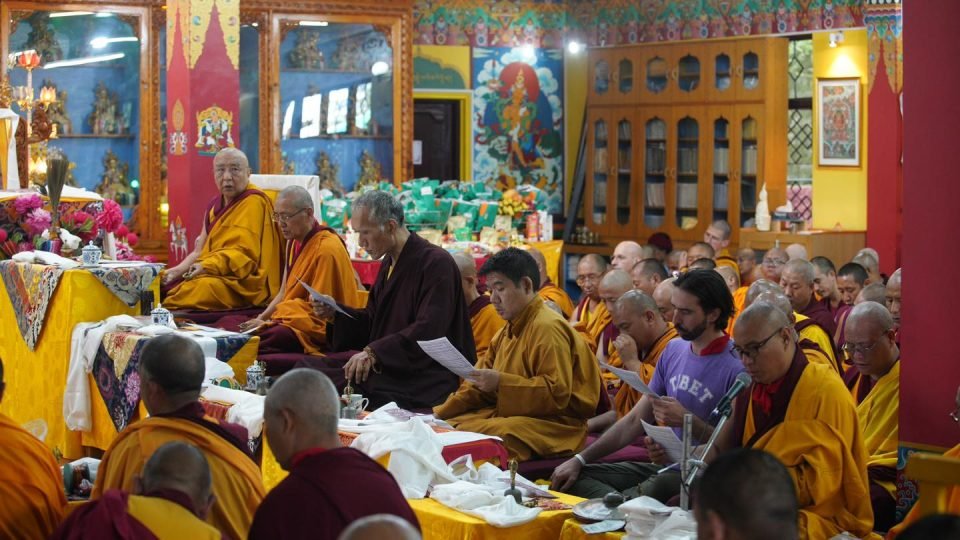
The Abbot of Namgyal Monastery Thamtog Rinpoche, Khenrinpoche Geshe Chonyi, Yangsi Rinpoche, Serkong Rinpoche, Osel Hita, and Kopan Umze at the Tara Puja commemorating the sixth week since Lama Zopa Rinpoche’s parinirvana, Tushita Meditation Center, Dharamsala, India, May 23, 2023. Photo by Kopan Monastery.
The evening before the long-life puja, Tushita’s amazingly hard-working staff and volunteers together with a crew of monks and nuns all pitched in to set up the main gompa at Tushita for a Four-Mandala Ritual to Chittamani Tara the following afternoon. Thrones for many lamas, piles of tsog, tormas, flowers, and other offerings for the puja had to be arranged since there would be no time after the long-life puja the next morning. At 2 p.m. on the 24th, a distinguished assembly of lamas, geshes, geshemas, monks, nuns and lay disciples packed Tushita’s main gompa to overflowing. Lead by Kopan Khenrinpoche Geshe Chonyi, together with the Abbot of Namgyal Monastery, Thromthog Rinpoche, His Holiness’ assistant, Yangten Rinpoche, President of Maitripa College, Yangsi Rinpoche, Osel (Hita) Rinpoche, Rigsel Rinpoche, Phuntsok Rinpoche and others, the assembly offered heartfelt prayers for Kyabje Lama Zopa Rinpoche to swiftly send forth another emanation to continue guiding us and carrying on Rinpoche’s enlightened deeds in this world.
Audience with His Holiness the Dalai Lama
Just a few days before the long-life puja it was decided that His Holiness would grant the FPMT students gathered in Dharamshala an audience in his private residence. On May 25, after lining up for a Covid test at daybreak and passing through security screening, we slowly filled the audience hall, awestruck by the magnificent statues and thangkas, abuzz with excitement at meeting His Holiness. When some of His Holiness’s close attendants first appeared, a hush fell over the group; then from way in the back someone began softly chanting OM MANI PADME HUM. Slowly all spontaneously joined in to respectfully receive the Buddha of Compassion.
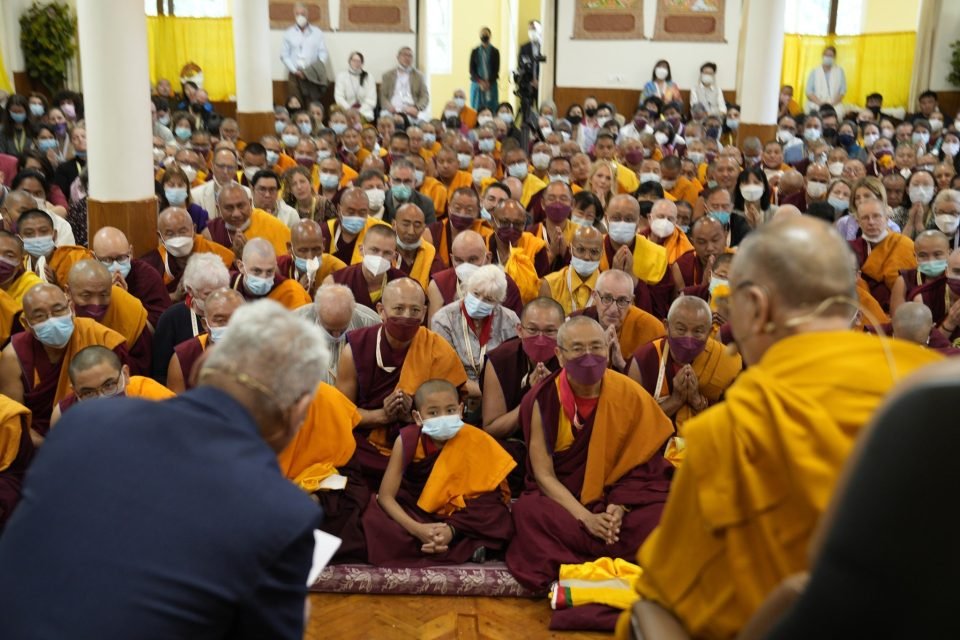
Rinpoches, Geshes, Kopan Sangha, and representatives and students of FPMT centers at the private audience
with His Holiness the Dalai Lama, Dharamsala, India, May 25, 2023. Photo by the Office of His
Holiness the Dalai Lama.
His Holiness began by recounting a dream which clearly indicated he would live until 110 years old, then said that despite the many troubles that come to his attention, his mind remains totally relaxed and positive. This, he observed, is due to his meditation on the attitude of bodhichitta and the view of emptiness. This and his determination to work for the welfare of sentient beings for as long as space remains have carried him with ease through even the most difficult situations. As His Holiness spoke with palpable warmth and affectionate concern, it felt as though he was revealing himself to us, a continuum of pure compassion and wisdom in perfect union ceaselessly appearing in life after life to benefit sentient beings.
His Holiness explained that his thorough familiarity with wisdom and compassion is due to his study of the classical Buddhist scriptures beginning in his childhood. He began telling stories illustrating the kindness of his own teachers, the past Kyabje Ling Rinpoche, Trijang Rinpoche and debate tutors. About twenty minutes into the audience His Holiness asked the attendants whether there wasn’t tea to be served. When they replied that none had been prepared, His Holiness said, “is it possible to prepare and bring some”. Twenty minutes later a group of Namgyal Monastery monks appeared with kettles of hot chai, and buns. As we sipped tea and the English interpreter translated, His Holiness playfully smiled at little Rigsel Rinpoche and called him up several times to take pieces of His Holiness’ bread.
The moment His Holiness first mentioned Kyabje Lama Zopa Rinpoche, it seemed as if we collectively got a lump stuck in our throats. But it quickly cleared as, without the slightest shadow of sadness, His Holiness fondly recalled his friendship with Rinpoche, and Rinpoche’s pure devotion and tireless service to the Dharma and sentient beings. As on the previous morning, His Holiness said that he would pray for a good reincarnation of Rinpoche to appear, one who can carry on the sacred work of Rinpoche’s life, and that we should do the same.
Then His Holiness spoke at length about the process of himself being discovered and identified as the reincarnation of the Thirteenth Dalai Lama. He told stories about visions in the sacred lake, Lhamoi Lhatso, about the Muslim warlord who first tested him, and about his reactions when the search party headed by Kewtsang Rinpoche first appeared at his home. Among the many details His Holiness related, was one thing Lama Zopa Rinpoche often used to recount – when His Holiness first met the search party, in conversation he told them, “I’m the one who works for the welfare of all sentient beings”.
In the last part of the audience His Holiness recounted more about how beneficial his studies of Buddhist scriptures have been for him. It is largely due to this that not only has he been able to navigate many difficult challenges in life with peace of mind, been able to perform well in his duties to lead the Tibetan people and serve the Buddha Dharma, but also that he feels great confidence when engaging with scientists and scholars from the West and other cultures. This is because the Tibetan lineage of Buddhism is firmly grounded in a logical approach to Buddha’s teachings as explicated by Dignāga, Dharmakīrti, Nagarjuna, Chandrakirti and other scholars of ancient Nalanda University. His Holiness explained that it is due his study of the commentaries by ancient Indian Buddhist masters that he has developed a broad understanding of Buddha’s teachings as opposed to many geshes who focus on their monastery textbooks (yigcha) and have a narrower perspective. This is also why he has been able to support his explanations with quotations from many sources, which His Holiness described as his offering of practice.
His Holiness graced us with nearly two hours of his eloquence, advice, and intimate reminiscences. There was a sense of having a close, loving connection. It was as if His Holiness were saying, now, amidst feeling the loss of your teacher Lama Zopa Rinpoche, trust in me, I’m here to guide you; and trust in the Dharma, bodhichitta, the wisdom of emptiness, and the determination to serve others which have been my own heart practice. Study, practice, and serve. Finally, His Holiness gave us each the opportunity to offer a kata and receive his personal blessing. It was an inexpressibly fortunate occasion.
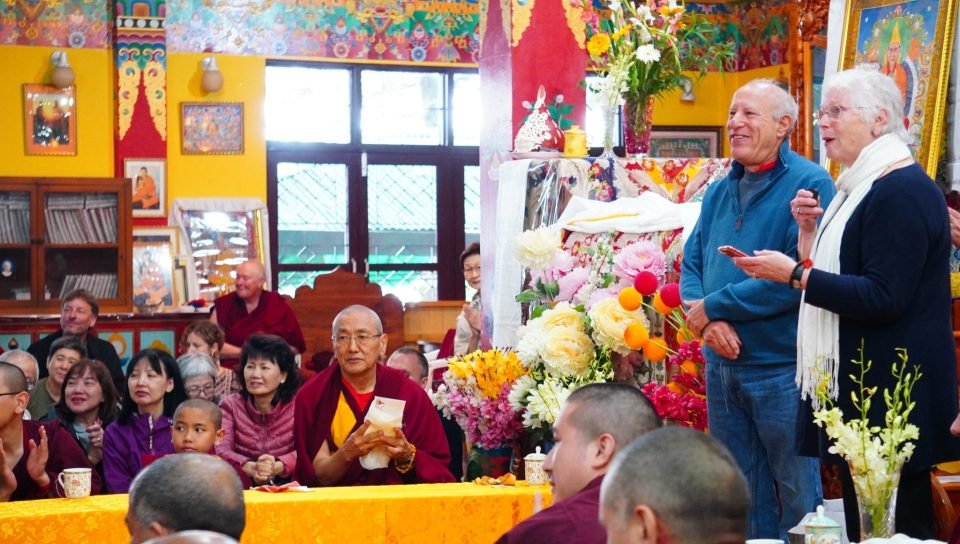
FPMT Board members Paula De Wys and Karuna Cayton thanking everyone for organizing the Long Life Puja for His Holiness the Dalai Lama
at the lunch at Tushita Meditation Center, Dharamsala, India, May 25, 2023. Photo by Tenzin Tsultrim.
FPMT Lunch
That afternoon, Tushita Meditation Centre prepared a sumptuous feast of Indian curries, pizzas, pasta, an ocean of mango lassi, and varied desserts as a way for all the FPMT family in the area to connect. Right at 1 p.m. when lunch was served, the sky burst open and poured down a torrential shower that sent all 250 attendees scrambling into the main gompa, where we enjoyed our lunch amidst a chorus of conversation. To conclude, Paula de Wys, on behalf of the FPMT Board of Directors, stood and thanked all those who worked so hard to make these wonderful events happen. It was moving to see and consider how so many – Kopan monks and nuns, Western ordained saṅgha, lay staff and students, from all branches of the organization – had coordinated so well, and worked seamlessly together to fulfill Rinpoche’s sacred wishes. Throughout I did not see one temper flair or hear one ill word spoken. Rather, all appeared to treat one another with respect, kindness, and genuine dedication to following Rinpoche’s impeccable guidance. I think Rinpoche would have been pleased, and that it bodes well for the FPMT going forward.
Tenzin Legtsok is an American Buddhist monk. He will soon complete the Geshe Studies Program at Sera Jey Monastic University in Karnataka, South India where he has studied classic Indian Buddhist treatise and their Tibetan commentaries in the tradition of ancient Nalanda University. He was ordained as a Buddhist monk by His Holiness the Dalai Lama in 2001.
For the past twenty years he has tried to make basic Buddhist teachings accessible to various audiences in India and the US through lectures, essays, and meditation instruction.
Foundation for the Preservation of Mahayana Tradition (FPMT), is a Tibetan Buddhist organization dedicated to the transmission of the Mahayana Buddhist tradition and values worldwide through teaching, meditation and community service.
12
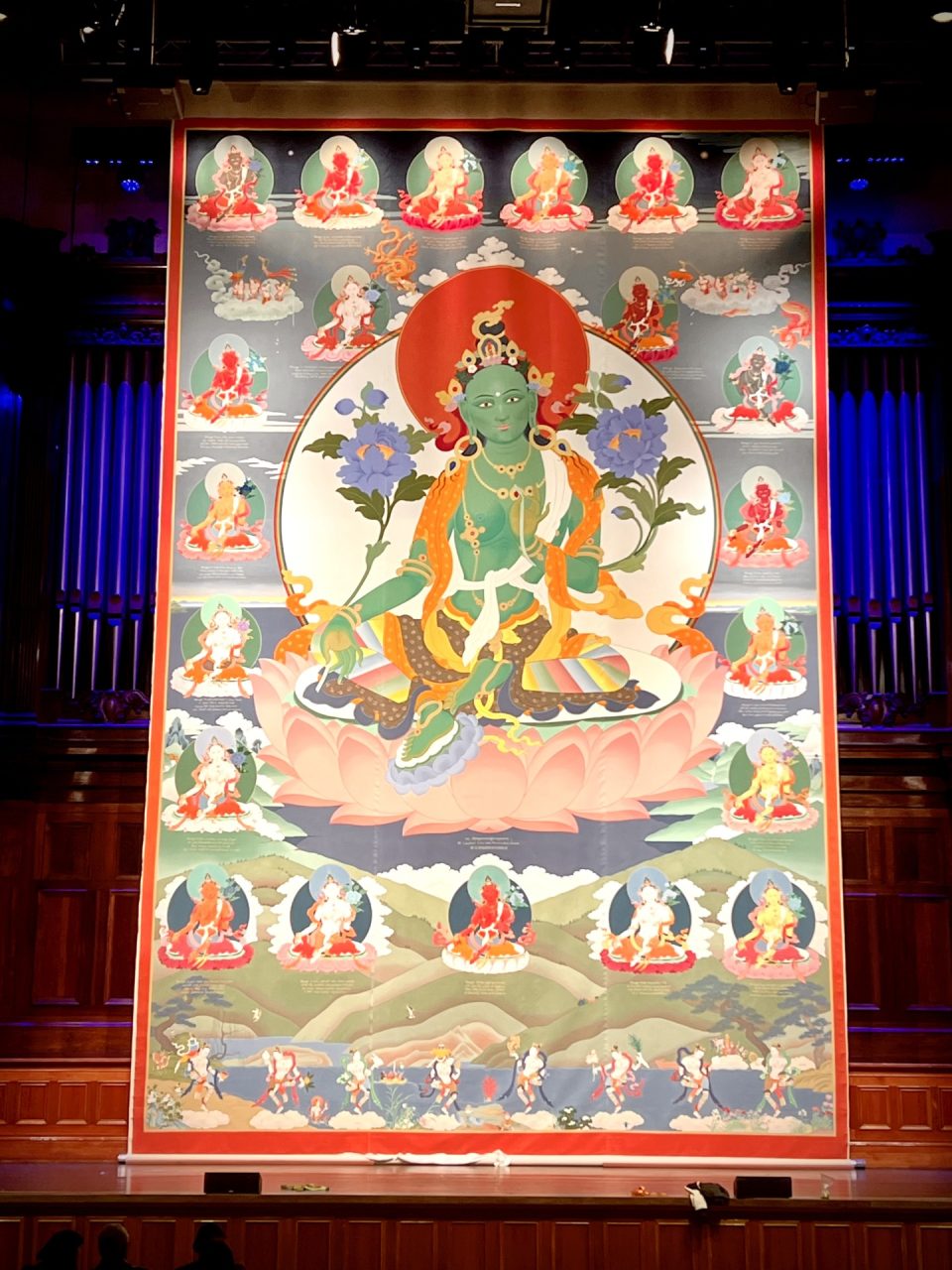
Large Twenty-One Tara thangka by artist Peter Iseli. Photo by Cynthia Karena.
In 2014, Lama Zopa Rinpoche commissioned Peter Iseli to paint a very big (49 ft x 30 ft) Twenty-One Taras thangka.
Peter and his wife Jangchub Iseli-Sangmo spent four years creating the thangka, one section at a time, in a studio at Institut Vajra Yogini in France.
At the end of 2017, Lama Zopa offered this thangka to Tara Institute in Melbourne, Australia, “to show to as many people as possible”.
Consecrated by several lamas, including Rinpoche, after completion in France, it was displayed twice: at Hamer Hall in Melbourne and at the retreat with Lama Zopa Rinpoche at the Great Stupa in Bendigo in 2018.
Rinpoche requested Peter to make further changes to the face of Tara, a rainbow around the central Tara’s aura, and the shapes of blue lotuses. In 2019 Peter made these changes and since then the thangka has been stored at Tara Institute.
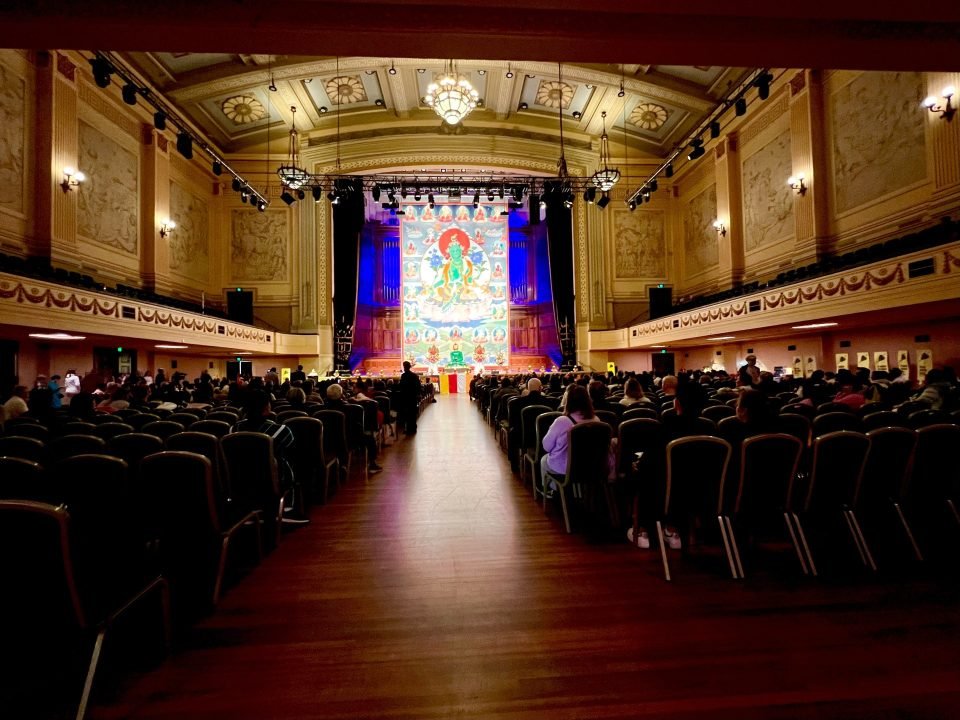
Display of the large Twenty-one Taras at the Melbourne Town Hall. Photo by Cynthia Karena.
Rinpoche’s wish to show this thangka to as many people as possible was fulfilled again by Tara Institute at the Victorian Celebration of the United Nations Day of Vesak on May 13, 2023. This multicultural event included a “Sangha Dana” lunch offering to sangha of all the different traditions, a Friendship Walk through the streets, and chanting and interfaith messages in the Melbourne Town Hall, where the Twenty-One Taras Thangka blessed everyone present, to a soundtrack of Lama Zopa invoking the Twenty-One Taras. One of the main coordinators, Jane Lewis, created a short video of the inspiring work behind the scenes.
“My wish is for the big centers in FPMT to have these large thangkas.” Rinpoche explained as part of his Vast Vision for the FPMT organization. “This is a way to leave imprints for all these people [who see them], for enlightenment.”
Several FPMT centers have commissioned large thangkas and are now hosting festival days where these holy objects can be enjoyed. We are also delighted to share that Amitabha Buddhist Centre, Singapore, once again displayed their 50 ft x 30 ft Amitabha Buddha thangka at their Vesak celebration the first week of June.
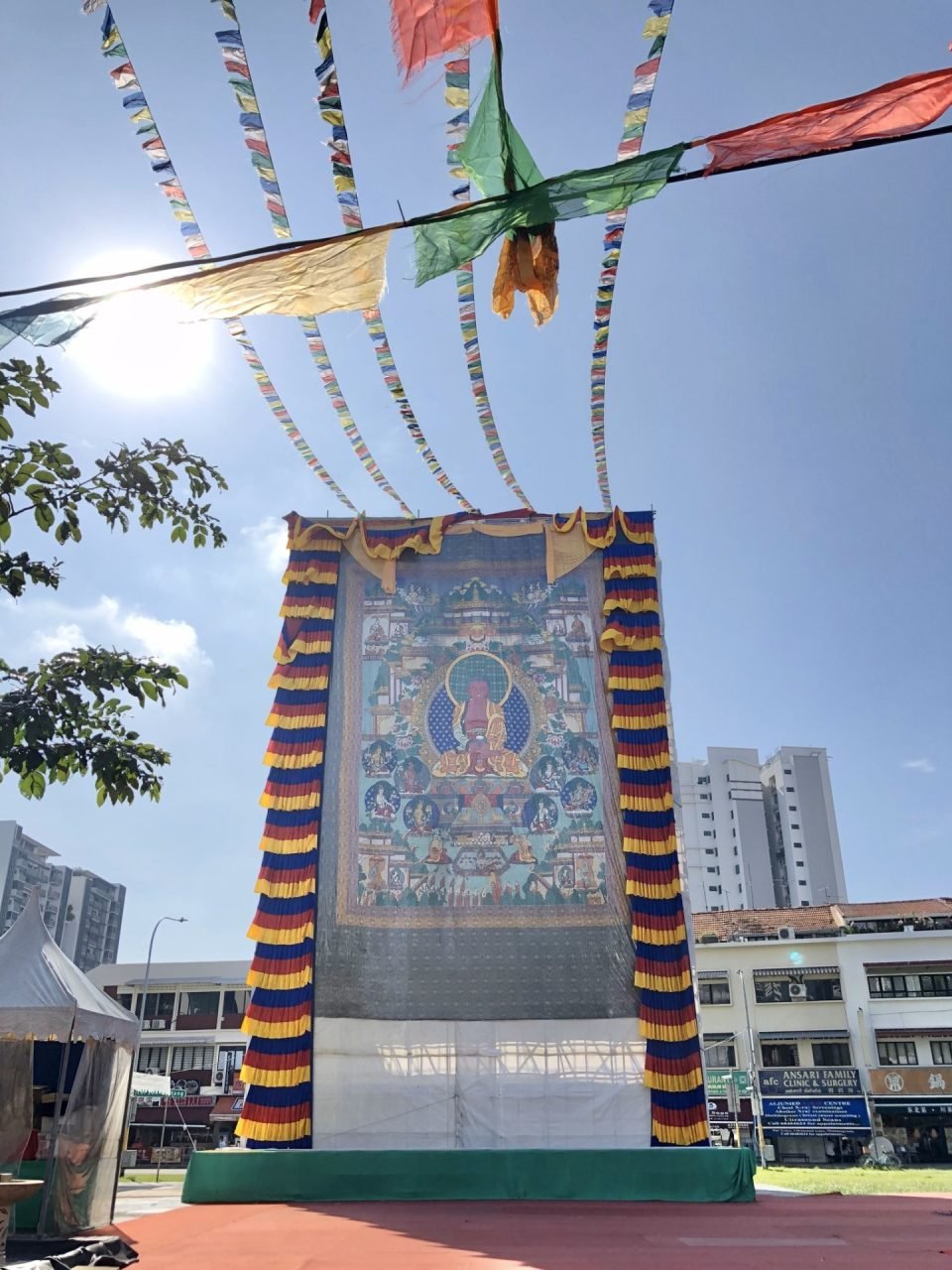
50 ft x 30 ft Amitabha Buddhist Centre thangka which was displayed at the ABC Vesak celebration. Photo courtesy of ABC Facebook page.
We invite you to rejoice in the displaying of these magnificent holy objects which, as Lama Zopa Rinpoche has explained, make it “so easy for sentient beings to purify their heavy negative karma and making it so easy for sentient beings to create extensive merit. Which makes it so easy to achieve the realizations of the path and so easy to achieve liberation and enlightenment.”
Foundation for the Preservation of Mahayana Tradition (FPMT), is a Tibetan Buddhist organization dedicated to the transmission of the Mahayana Buddhist tradition and values worldwide through teaching, meditation and community service.
- Tagged: large thangka
9
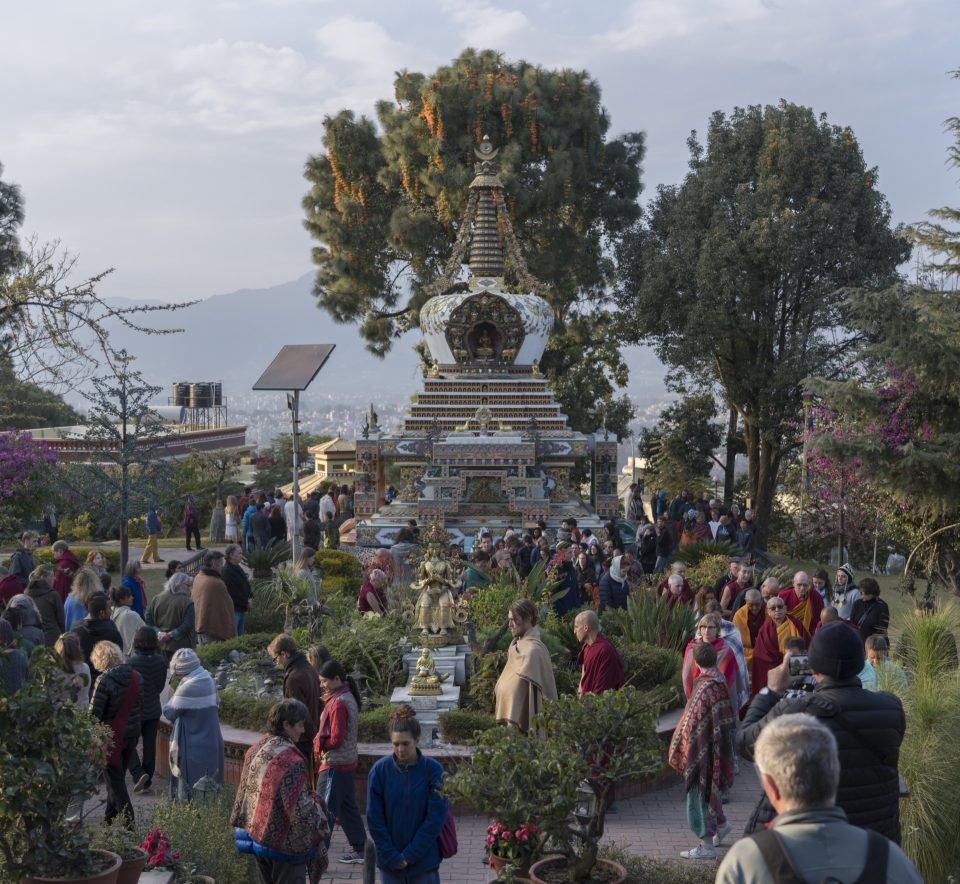
Lama Zopa Rinpoche leading students in walking meditation around the stupa and grounds of Kopan Monastery, 2018. Photo by Ven. Lobsang Sherab.
As we have previously shared, this year’s Light of the Path retreat (LOP) at Kopan Monastery, Nepal, will take place as planned from September 3-17, 2023.
Ven. Rene Feusi will lead most of the afternoon meditation sessions and senior FPMT registered teachers will lead the other sessions. Geshe Tenzin Legtsok will be the retreat leader. The schedule will be as follows:
- Mornings will begin with Lama Zopa Rinpoche’s morning motivation followed by precepts (every second day), prostrations, and extensive Lama Chopa Jorcho practice; Rinpoche’s heart practice.
- Afternoons will have three meditation sessions. The meditations will be based on extracts of Rinpoche’s previous LOP teachings and on video clips.
- Evenings will involve walking meditation alternating with personal stories, followed by Protector prayers, Vajrasattva purification practice, and dedications.
After the LOP retreat Kopan will organize three pilgrimages to Boudhanath Stupa, Pharping, and Swayambunath Stupa; and will also be hosting a Foundation Service Seminar (FSS) from September 21-26. The FSS is for anyone wishing to offer service in the FPMT organization. Kopan Monastery is the home of the FPMT organization, and so it is very precious to host a FSS right after the Light of the Path Retreat. We hope that this scheduling makes it easy and more affordable for FPMT students to participate in both.
The Foundation Service Seminar explores how we can best offer our skills and develop our qualities in service. It provides a firm basis to serve effectively and joyfully within the FPMT organization by developing a shared understanding of the FPMT mission and how that translates into action for centers, projects, services, study groups and individuals. Those who have participated in the FSS have felt re-energized by it, and always recommend it. The FSS is an opportunity to experience FPMT “family feeling” and to nourish existing and prepare future directors, SPCs, board members, staff and volunteers.
Kopan Monastery will continue offering Light of the Path retreats in the upcoming years in order to cover the whole lamrim, based on Lama Zopa Rinpoche’s teachings during previous Light of the Path retreats. The meditation topics to be covered during LOP 2024, will be those of the middle capable being and during LOP 2025, those of the higher capable being. In this way, Kopan will be providing an opportunity to continue practicing together as a loving and supportive FPMT family and maintain Rinpoche’s blessings in our hearts.
There are still spots available for this Light of the Path Retreat and those interested should read further information provided by Kopan Monastery.
There is also still space available for the Foundation Service Seminar. For more information on the Foundation Service Seminar, visit FPMT Service Seminars. You can also read more about past Foundation Service Seminars held around the world.
Foundation for the Preservation of Mahayana Tradition (FPMT), is a Tibetan Buddhist organization dedicated to the transmission of the Mahayana Buddhist tradition and values worldwide through teaching, meditation and community service.
8
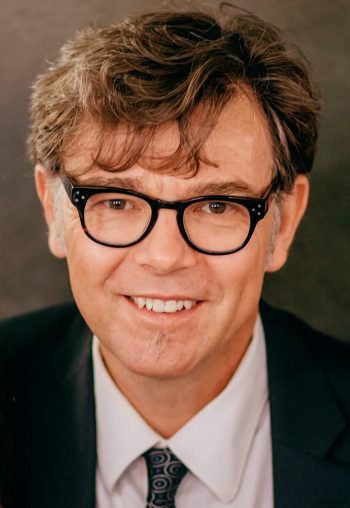
Arunas Antanaitas, photo courtesy of Arunas’ Facebook page.
Arunas Antanaitas, 62, passed away peacefully on Vesak, May 5, 2023 in Dundas, Ontario, Canada, of cancer.
Arunas had embarked on his cancer journey 17 months prior with grace, dignity, and a contagiously positive outlook. His last days were filled with prayers, surrounded by his loved ones. Arunas will be remembered for his compassion, love of conversation, propensity for playfulness, and unwavering desire to help others.
Arunas served as the center director for Lama Yeshe Ling, seeing the center transform from a meeting place in his and Sharon’s basement studio to hosting our resident teacher Geshe Sonam Ngodrup (Geshe Sega) and Tibetan language interpreter Venerable Jamyang Khedrup. Our community supported Arunas in his wish to serve as director until his last breath, with Lama Zopa Rinpoche’s last advice to Arunas being for him to rejoice in his having served Rinpoche in this way. During his illness, Arunas was able to fulfill all of Rinpoche’s advice, along with the support of our community. For example, Geshe Sonam conveyed the Amitayus Long Life initiation, we did many group recitations of the long life sutra, and an animal liberation. A month earlier, Khensur Rinpoche Lobsang Delek taught at Lama Yeshe Ling and conferred the initiation into Arunas’ main practice. Khensur Rinpoche remarked that he was impressed that Arunas attended every event despite it being so very clear that Arunas was very weak and in pain.
In one of the last letters to Lama Zopa Rinpoche, Arunas asked if Rinpoche agreed with the doctor’s view that he had now become ‘palliative’. Rinpoche’s reply was: “a good practitioner is always palliative”. Arunas had discussed and coached his family and the hospice staff about the Buddhist view and practice of dying, and everyone was supportive of how he wished to die. They found a hospice that supported leaving his body undisturbed for three days. At the hospice, Geshe Sonam and Khedrup came to visit, as well as fellow practitioners several times coming together to meditate and pray. Moments after Arunas’ last breath, Geshe la, Khedrup la, and a small group of sangha and family performed the Guru Puja, with Geshe la leading us in visualizing Arunas receiving the four initiations, and the dissolution of the guru in the heart.
One of the palliative care nurses mentioned that everyone she had cared for there was afraid of death, as was she. It was remarkable for her to observe that Arunas was not afraid, and neither were the people around him. Arunas wanted to live longer, and he did everything possible to do so, for he had more he wanted to offer. It is sad that this good person is no longer with us here. However we know this isn’t the end, and we pray that Arunas finds the way to manifest again as a good person, to connect very early with the Dharma, and continue his path of service to the guru for the benefit of beings.
Please pray that Arunas may never ever be reborn in the lower realms, may he be immediately born in a pure land where he can be enlightened or to receive a perfect human body, meet the Mahayana teachings and meet a perfectly qualified guru and by only pleasing the guru’s mind, achieve enlightenment as quickly as possible. More advice from Lama Zopa Ripoche on death and dying is available, see Death and Dying: Practices and Resources (fpmt.org/death/).
To read more obituaries from the international FPMT mandala, and to find information on submission guidelines, please visit our new Obituaries page (fpmt.org/media/obituaries/).
- Tagged: obituaries, obituary
22
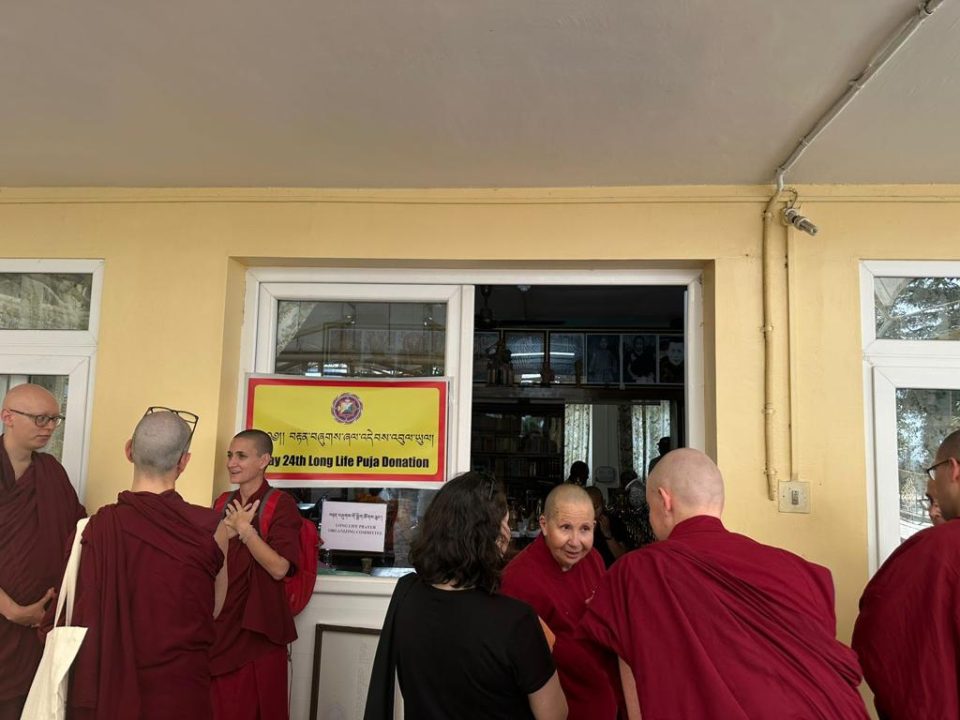
Front of the FPMT Office in the Debate Courtyard of Namygyal Monastery, Mcleod Ganj, India.
Joyous preparations are underway for the long life puja that will be offered by the FPMT organization to His Holiness the Dalai Lama at Namgyal Monastery, Mcleod Ganj on May 24. Hundreds of statues are being filled, tormas made, consecration pujas for the statues offered, and extensive offerings prepared.
The Kopan monks and nuns are working so hard– we offer them tremendous thanks and also grateful thanks to the hard work of Geshe Ngawang Sangye and to Tushita Meditation Centre for all the kindness hosting and taking care in so many ways. This is also possible thanks to the kindness of generosity of all the donors, volunteers, and whole FPMT family. May all the prayers of the puja be actualized!
We also have very wonderful news for FPMT students who are gathering from all over the world for the long life puja!
His Holiness has accepted to give an audience to FPMT students at His Holiness’s residence in Mcleod Ganj on May 25.
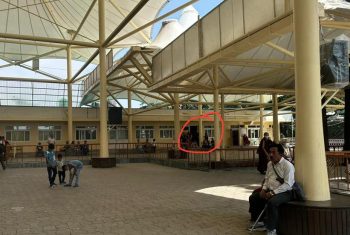
FPMT Office located in the Namygyal Monastery debate courtyard.
The audience will start at 7a.m., so please gather at the entrance to the palace (which is behind the Namygyal Monastery debate courtyard) at 6.30 a.m. Everyone will need a security pass. Those sitting inside the temple or in the offering procession for the long life puja can use the same security passes.
Other FPMT students will need and be able to get a security pass from the FPMT office in the debate courtyard (please see photo). You will need to bring your passport with your Indian visa, and a passport photo. These security passes will need to be obtained by the 24th at the latest.
We recently shared the text that will be used in this long life puja for His Holiness. All are welcome to download this text and follow along during the event.
You can follow important news about His Holiness the Dalai Lama on the official website of His Holiness:
https://www.dalailama.com/news
19
May 2023 e-News is Now Available
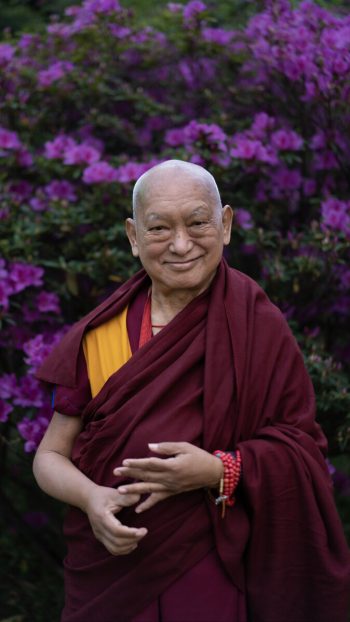
Lama Zopa Rinpoche in Nepal, March 27, 2023. Photo by Ven. Lobsang Sherab.
We have a lot to share in this month’s e-news.
We have compiled information about all of the new resources, web pages, event updates, and important information shared since Lama Zopa Rinpoche showed the aspect of passing away on April 13, 2023.
We hope this will serve students well to access all that is available, including:
- Recent updates from FPMT International Office
- Practices for Rinpoche’s Swift Return
- Tributes and condolences received
- Information about the upcoming Long Life Puja for His Holiness the Dalai Lama
- FPMT Statement in Support of His Holiness
- Important dates and events
- Updates from within the FPMT community
Please read this month’s e-news in its entirety.
Have the e-News translated into your native language by using our convenient translation facility located on the right-hand side of the page.
Visit our subscribe page to receive the monthly FPMT International Office e-News directly in your email inbox.
- Tagged: fpmt enews
18
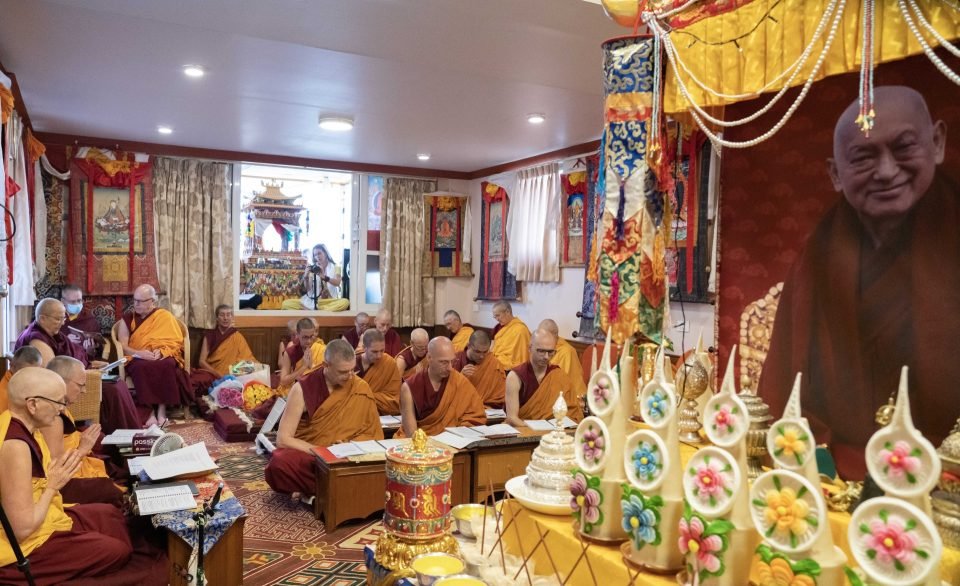
International IMI Sangha offering prayers each day in front of Lama Zopa Rinpoche’s holy body, Kopan Monastery, Nepal, April 21, 2023. Photo by Ven. Lobsang Sherab.
“It’s simply impossible to express how beautiful it is in Rinpoche’s room right now,” Ven. Sarah Thresher shared on her Facebook page from Kopan Monastery on May 4, 2023, two weeks after Lama Zopa Rinpoche showed the aspect of passing away on April 13, 2023. “Kopan has done everything to make it the most extraordinarily beautiful and breathtaking offering for Rinpoche. I hope you all will have a chance to visit in the future and appreciate the love and devotion and majesty of Rinpoche’s mandala. I have watched this transformation over the past two weeks and I’m so grateful.”
We are so fortunate that Ven. Sarah took the time to share what it has been like at Kopan during this devastating and moving time. With Ven. Sarah’s permission, we are sharing some of the detailed reports she has written about how “every inch of Kopan” has been in prayer and service as several thousand individuals have come to pay respects to Rinpoche and process this immense loss. The supportive and kind atmosphere, impeccable coordination and handling of logistics, and the care and detail needed for Kopan to receive and care for hundreds of guests from around the world daily—this effort at a time of losing the guru is something to truly consider and rejoice in.
We have kept Ven. Sarah’s entries dated so readers can appreciate how the events were being experienced in real time.
April 23, 2023: It All Happened So Fast!
I was at Kopan shortly after Rinpoche arrived back from Tsum—having received a cryptic message that it was “very important” I come up immediately. When I arrived at the monastery it was strangely quiet and I wondered around trying to find somebody to talk to—at the same time messaging a friend in Tsum to see if I could get some clues. When I reached the stupa garden I met some people I knew in shock and gradually the truth started to be revealed…
It all happened so fast! Those early hours were confused and the initial days were a time of shock, disbelief and grieving. We didn’t definitively know what had happened that day until the email from Ven. Roger was sent out—so that was roughly the same time as everyone else around the world found out. We knew that Rinpoche had returned from Tsum, there was an emergency situation and the news was bad—but nobody wanted to express the words that would make things clear. We were simply told that “Rinpoche was in meditation… His Holiness says Rinpoche has not yet gone.”
That first afternoon monks gathered for a Cittamani Tara puja in a strangely empty main gompa joined by a handful of Westerners. It was quite surreal—hard to believe this was actually happening. Kopan was full of new people attending an introductory course, which was gradually cancelled as nobody had the will to teach any more.
The second day we began to do Tara prayers at the Chenrezig gompa in English. His Holiness’ immediate advice had been to do Cittamani Tara Four Mandalas. We were still just a few people as many of the usual residents at Kopan were gone. A lot of time those first few days was taken up responding to messages from around the world and encouraging people to come if that was in their heart, even though we had no idea how things would unfold. It was hard to sleep or eat. The mobile phones were “ringing off the hook” and that added to the tension and distress.
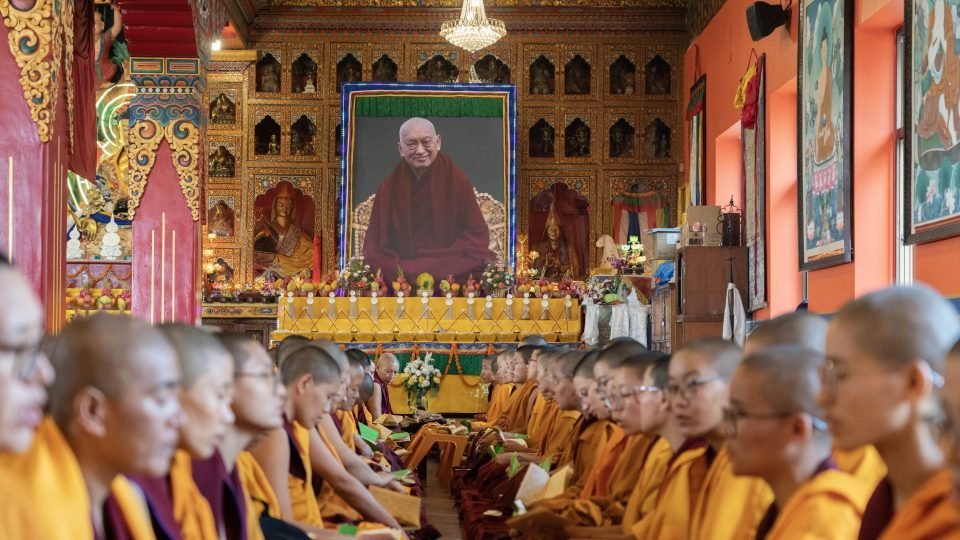
Chittamani Tara puja in Kopan Moanstery gompa, Nepal, April 17, 2023. Photo by Ven. Lobsang Sherab.
By the fourth day people from the introductory course had mainly left and Rinpoche’s students were starting to arrive from around the world. By now, we had a full schedule of prayers in the Chenrezig gompa. The day began with Rinpoche’s morning motivation and 35 Buddhas’ prostrations before breakfast, then Lama Chopa Jorcho before lunch, Cittamani Tara Four Mandalas in the afternoon, and Vajrasattva practice with dedication prayers after dinner. Of course there were prayers in the main gompa all day long with the Kopan monks and nuns but everything was in Tibetan and chanted very fast so it was hard to follow. Ven. Roger had requested a program for English speakers as well.
Interspersed with the prayers we began small group sessions for people to share about how they met Rinpoche, what Rinpoche meant to them, how they heard the news, and how they felt going forwards. This was very healing, moving and inspiring. When Osel Rinpoche arrived he agreed to come and talk to us. He told us not to focus on the loss but on the gratitude for everything we had received—then we would always feel Rinpoche in our hearts. It was powerful advice.
The monks and nuns of Kopan were extremely impressive. From the moment Rinpoche entered into the final meditation mandalas, torma, and all the necessary materials were assembled and a rota of shifts manifested so that the prayers in the room next to Rinpoche’s holy body were unceasing day and night. As the days unfolded and more and more people arrived, it felt as if every inch of Kopan was in prayer. Upstairs there could be different groups of tantric monks and high lamas and heart disciples in prayer in the different rooms at Rinpoche’s apartment, while down in the main gompa monks and nuns packed into the space to do extensive prayer sessions and recitations. Outside in the debate courtyard there was tea and snacks for visitors; and groups were coming to do their own very moving practices to pay tribute to Rinpoche. Meanwhile the young monks huddled together to recite mani mantras and we internationals were following our own schedule in the Chenrezig gompa.
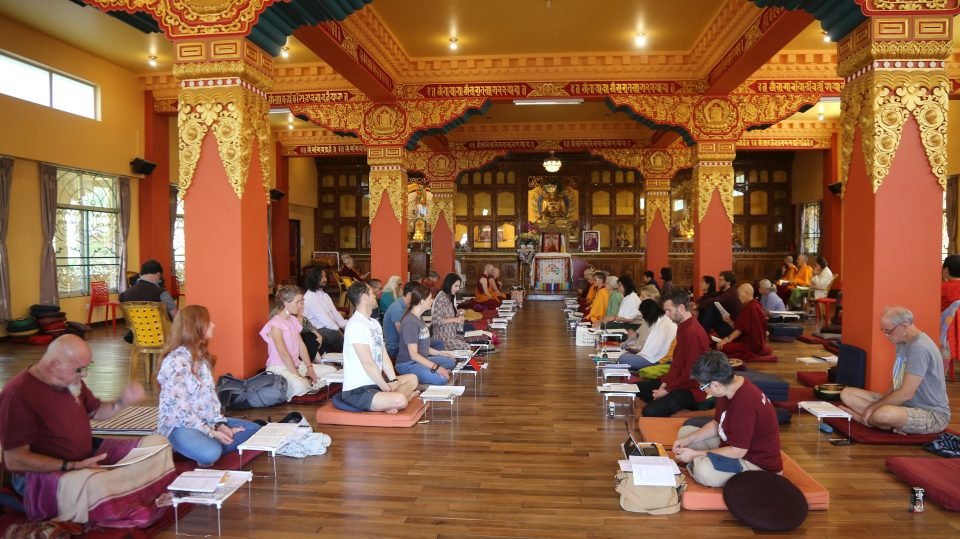
Students doing prayers for the swift return of Lama Zopa Rinpoche in the Chenrezig gompa. April 21, 2023. Photo by Capucine
Redon.
It was so moving to see the high lamas who, from their own side, immediately flew in to Nepal to do prayers, the many students from around the world, and masters and disciples from other traditions come up from the valley to pray and practice out of respect for such a great holy being.
Also incredible has been the generous sharing of images of Rinpoche in meditation and livestream of the continual prayers and the tributes and long life prayers, which meant that people all over the world could feel connected to Rinpoche and what was happening here.
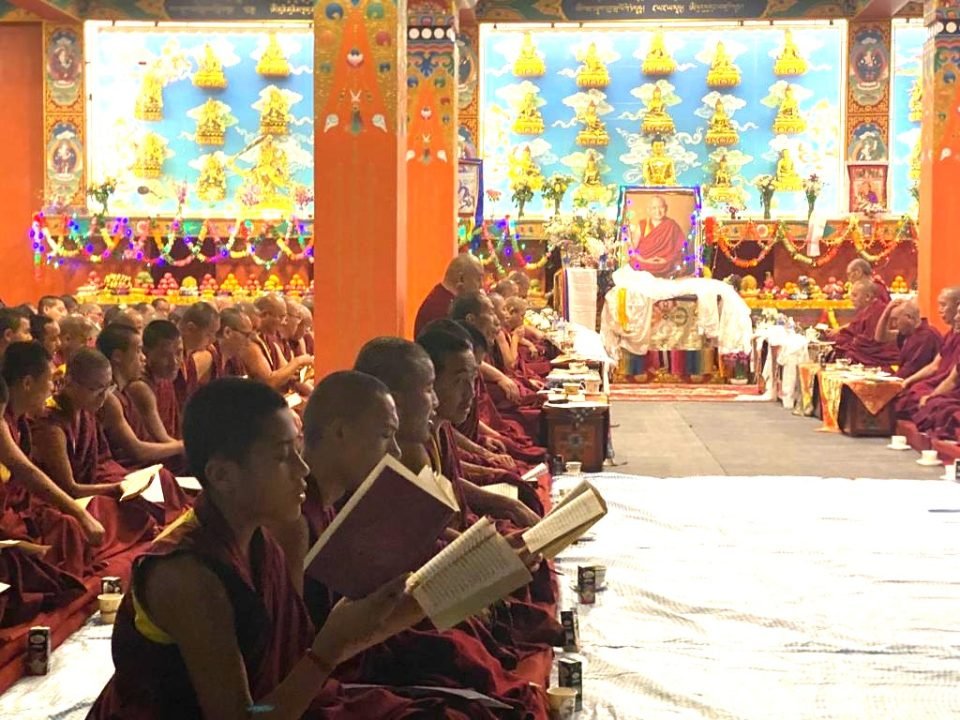
Young monks in prayer at Kopan Monastery. Photo by Alison Murdoch.
We are now on the 11th day. The extraordinary abundance of pujas all over Kopan has calmed. Prayers are still held at Rinpoche’s holy body non-stop. Our retreat schedule of prayers for the international students continues and now in the afternoon we split up into three groups: one in the Chenrezig gompa doing Tara puja, one at the Boudha Stupa offering room doing the extensive offering practice, and one that does prayers in English advised by Khen Rinpoche Geshe Chonyi at Rinpoche’s holy body.
We have a routine to facilitate reflection on lamrim as Khadro-la advised, people are being so kind and supportive to each other, and outside caterers make sure we are well fed and nourished. People are coming from around the world for a day, two days, a week, a month, as they wish to pray and pay respect to our most incredibly cherished and kind Spiritual Guide, to make sense of this great loss and reflect on the future. I see people arrive in tears and leave with laughter and a renewed sense of commitment to continue and fulfil whatever advice Rinpoche has given.
My heart aches for those who were not able to meet with Rinpoche. Those of us who did will always cherish our time spent together and the teachings we received. I can only hope that we can communicate some of that extraordinary blessing to others.
May Rinpoche quickly return in a new incarnation to guide us, and may we all continue his most incredible work, complete the projects, abide purely in our commitments, and always be most pleasing to the Spiritual Guide.
May 2, 2023: Twenty Days of Sorrow, Twenty Days of Gratitude
It’s been twenty days now since Rinpoche suddenly left us—twenty days of sorrow, twenty days of continual prayers and practices, twenty days of offerings and twenty days of unending gratitude for having met Rinpoche and all we have received.
Upon hearing the initial news, many people’s hearts turned to Kopan. The early days were filled with pujas and prayers in every corner of Kopan with many monks and nuns and locals. Then, within days, people were flying in from around the world to pay respect to Rinpoche and gather for prayers and practice. That has been truly inspiring—as Rinpoche used to say before we would offer long life puja, “The prayers the lama does for the disciple have great power and the prayers the disciples do for the lama have great power.”
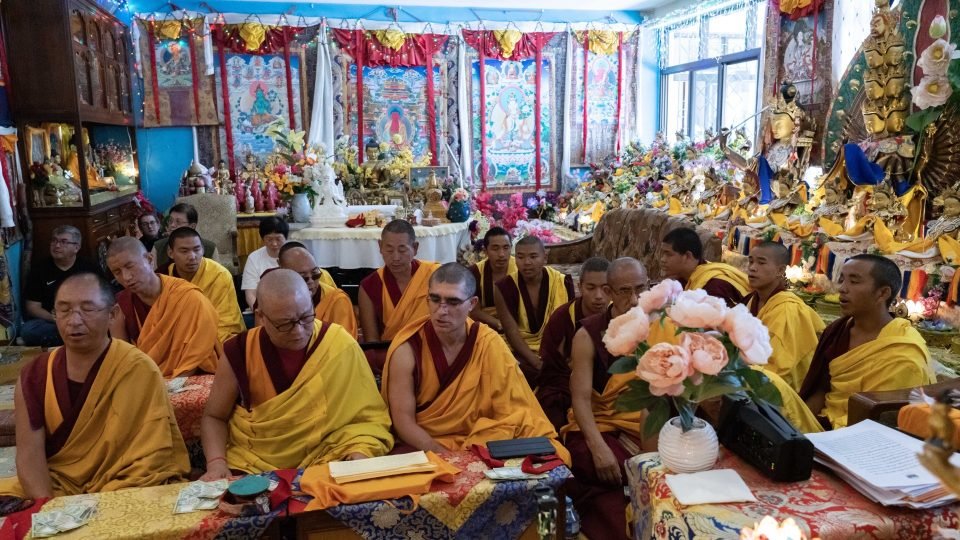
Kopan senior monks and Lama Gyupas offering prayers in front of Rinpoche’s holy body, Kopan Monastery, April 22, 2023. Photo by Ven. Lobsang Sherab.
Now all that busy-ness has calmed. There is still continual practice at Rinpoche’s holy body by different groups throughout the day and night which is livestreamed for all to share. The Kopan tantric monks do Yamantaka self-initiation early morning, the Thame monks from Solu Khumbu do Chenrezig practice early afternoon, the Westerners do various prayers late afternoon, and the Kopan nuns do Vajrayogini self-initiation every evening. There is also all-day Heruka Lama Chopa Tsog every 7th day with the monks and nuns and lay people coming together. Additionally, people are always welcome to come and offer khata to Rinpoche’s holy body and make prayers and circumambulate as these practices are happening. The mandala house where Rinpoche’s holy body is kept becomes more and more beautiful every day. There are silver bowls and butter lamps, banners and parasols and pennants and silk khatas, pearls and food and incense and flowers all around. The sacred and blessed energy in Rinpoche’s room—the place where in recent years Rinpoche spent most of the time—is palpable.
As things begin to calm, many of the visitors who initially arrived are now leaving and we international guests have trimmed down our “retreat-style” practices to a morning session of Lama Chopa Jorcho and an afternoon session of Cittamani Tara or other prayers with occasional pilgrimages. Those who leave express gratitude for the time spent here—the sharing, the opportunity to be part of this gathering of disciples and the blessing of feeling Rinpoche’s presence, and also the hope for the future.
Last week Yangsi Rinpoche very kindly agreed to talk to us before leaving Kopan—though not to be recorded. It took the aspect—as I perceived it—of a profound sharing from a highly accomplished disciple to us newbies—and I hope its okay to share just a few of my reflections on what Rinpoche said—though not everything.
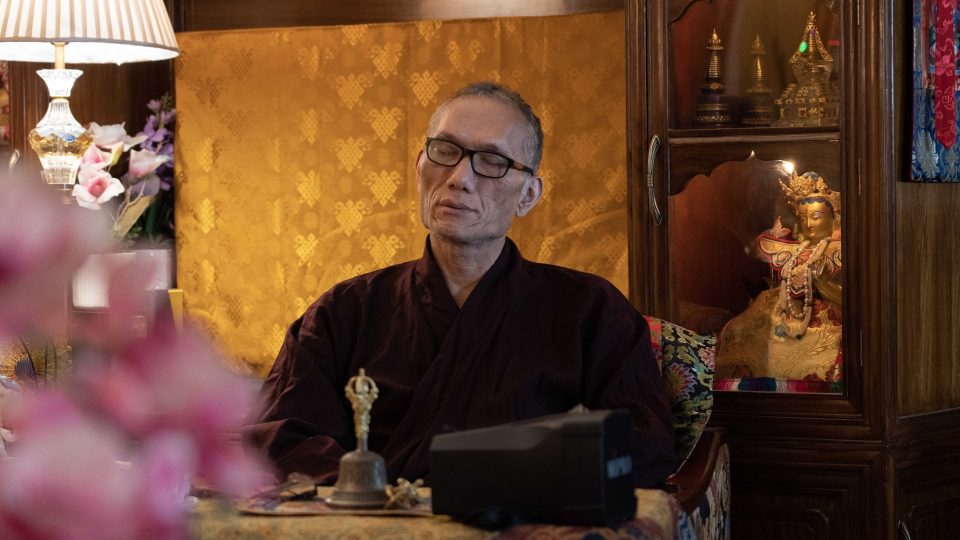
Yangsi Rinpoche offering prayers at Kopan Monastery, April 20, 2023. Photo by Ven. Lobsang Sherab.
Yangsi Rinpoche spoke about how we should consider ourselves most fortunate to have actually met Rinpoche—as Rinpoche will now take a place in history as one of the great masters. Up to now we have been carried along by Rinpoche’s great compassion and vast enlightened activity, but the free ride is over. Now it’s time to repay that kindness. We owe it to Rinpoche to continue the work he began and particularly to take responsibility for Rinpoche’s main project—to free us from our self-cherishing and self-grasping. Yangsi Rinpoche expressed that yes pujas and prayers are good—but if we can reduce our self-cherishing and self-grasping for even a second it is the best offering and Rinpoche will shower us with flowers and cheesecake from the pure lands!
Yangsi Rinpoche also mentioned that Westerners have a unique karmic connection with Lama Yeshe and Rinpoche. Just as we read about previous buddhas making prayers to benefit different beings at different times, it seems Lama and Rinpoche made prayers to benefit the hippies in degenerate times! There are other highly qualified lamas but we didn’t have the connection with them—it was Rinpoche and Lama that brought us onto the path. Therefore, we have a particular responsibility and owe it to Rinpoche to repay the kindness—to reduce the thought that we are the center of the universe and everything is about me, me, me and instead work for others.
Rinpoche has given us enough teachings for several lifetimes. It’s not necessary to go and find another guru—we already have what we need. Now we owe it to Rinpoche to practice and internalize what we have received. And, as for Rinpoche, he is now everywhere—free from the limitations of the physical body.
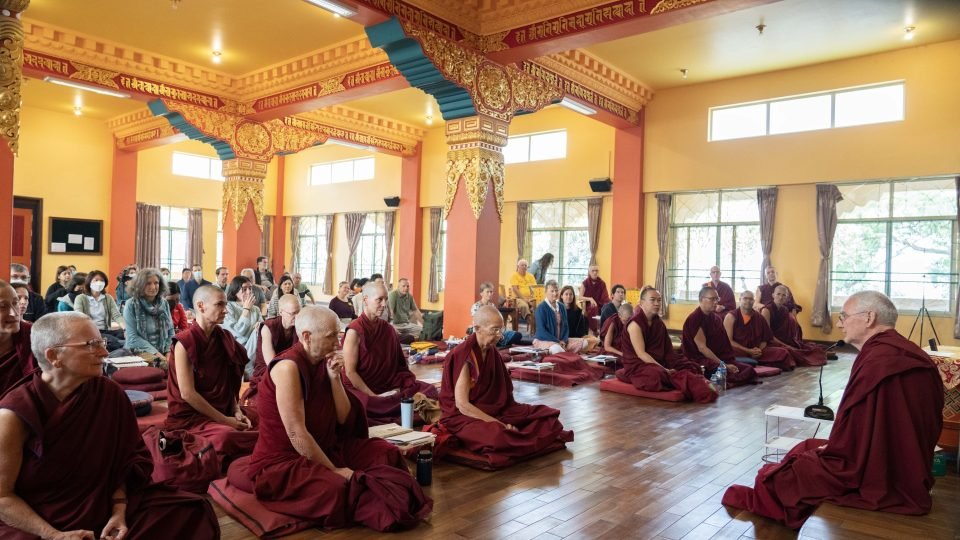
Ven. Roger Kunsang giving talk to the International Sangha and students explaining the details around Lama Zopa Rinpoche showing aspect of passing away, April 28, 2023. Photo by Ven. Lobsang Sherab.
Ven. Roger also came one night to talk to us after returning from a meeting with His Holiness Dalai Lama in Dharamsala. He walked us through what had happened leading up to and then on the actual day that Rinpoche left us. It was quite emotional for many of us listening and also not to be shared. There is a video of the meeting with His Holiness now available for all to view and His Holiness clearly says that he will take personal responsibility to check for Rinpoche’s reincarnation—there is great hope for the future.
The prayers will continue here at Kopan until May 31 when many people are expected to join for the final puja. I hope all of you will rejoice and join with us in supporting what the monastery is doing. Thank you.
May 6, 2023: We Wait, We Pray, We Continue—We Try to Repay The Kindness
Outside the Kopan gates people continue to arrive from around the valley and further by taxi, by car, by scooter, by plane, walking—visiting the beautiful mandala that has become Kopan to pay respects to the crown jewel—our most precious lama. They are greeted by the nuns in the debate courtyard at tables with snacks and chai before winding their way upstairs to Rinpoche’s room.
Rinpoche who continuously prayed during his lifetime to benefit those who saw, touched, or even thought about him—continues to do so after passing. He gave his holy body to us while he was alive and left it for us now that he is gone—always showing the most extraordinary activity of a great bodhisattva. I cannot express enough my gratitude to HE Ling Rinpoche for advising us to keep and preserve Rinpoche’s holy body—every atom of which is a pure holy relic. We can also receive and treasure blessed salt from the embalming process as a holy relic.
Upstairs two nuns are stringing Swarovski pearls flown in from Singapore with local precious stones to adorn Rinpoche’s mandala house. A few days ago the old mandala house was replaced by a new cabinet made by the carpenters and painted by the local artists. There are now silks and brocades, pennants, banners, umbrella, khatas, fruits, flowers, silver bowls, lights, and an extraordinary beautiful display of offerings that adorn the new mandala house. It’s simply not possible to describe the sacred energy in Rinpoche’s rooms where prayers continue to take place around the clock and visitors stream by to pay respect. People will usually sit and join the prayers for a short while before leaving with their choice of photo of different shots of Rinpoche—each one beautiful and printed with the slogans we have come to know and love below Rinpoche’s image—“Live with compassion, work with compassion, meditate with compassion, die with compassion, enjoy with compassion…” “Less desire means less pain…” etc.
The normal schedule for us internationals is relaxed today as we just completed an all-night Tara practice—the Tara Purification Ritual. Tara practice was recommended by His Holiness Dalai Lama within the first hours of Rinpoche entering meditation and this Tara night practice was composed by Rinpoche’s other root guru His Holiness Trijang Rinpoche. We have been doing Tara continuously but last night took the opportunity of the lunar eclipse to stay up and praise, prostrate, make offerings, and circumambulate Tara from sunset to sunrise. It was a special night. The Tara altar was set up in the Chenrezig gompa but people could also circumambulate in the stupa garden where trees of lights offered by Chinese students over the past years illuminate the holy objects—and all of this as Rinpoche’s holy voice sang out the Twenty-one Tara Praises for us to follow.
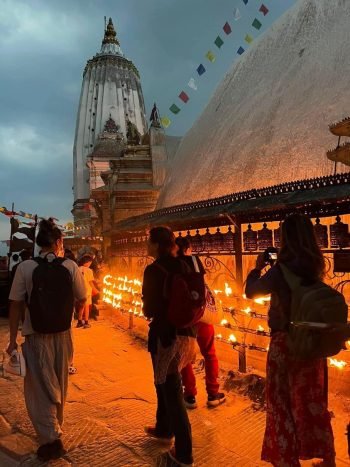
Light offerings by students at Swayambhunath Stupa, April 23, 2023. Photo by Bec French.
The mood at Kopan is good. So many people have flown in for just a few days and left uplifted. Rinpoche is so present everywhere and of course we feel him at the heart center of the FPMT—Kopan—where it all began. But those who fly in also go on pilgrimage to the other holy places in the valley—the three great stupas, the special White Tara, Pharping and so on—to offer prayers. Some have even made the trip up to Lawudo to sit and pray in Rinpoche’s cave and gompa.
A week or so ago, Ven. Roger gave a talk about the events around Rinpoche leaving us. Nobody expected this or could have anticipated it. It was a last final teaching to cut our habitual concept and clinging to permanence. At the end I asked him about the advice for the future. He replied: “The advice is simple—we continue the work Rinpoche has done. We repay the kindness.”
And so we wait, we pray, we continue. Nobody can take the place of Rinpoche except Rinpoche’s next incarnation. However long that takes, none of us have been left with our hands empty—there are so many projects and centers to benefit others. Over half a century Rinpoche has given so much advice, so many teachings and practices. When Rinpoche returns, instead of having to subdue barbarian and hippie Westerners to bring them on to the path for their own and others’ ultimate benefit, let’s hope we are ready to go. As Rinpoche said at a CPMT meeting some years back—FPMT has not begun yet. There is nothing but hope for the future.
May 11, 2023: Kindness and Support
Yesterday was the fourth week since Rinpoche entered the final meditation. It’s been an intensive time for everyone but there has also been so much kindness and support.
From the beginning Kopan has focused on the prayers for Rinpoche and the guests who come to pay respect and participate. Within days, the monastery was welcoming eminent high lamas including the Ganden Tripa, Segyu Khen Rinpoche Geshe Wangdu, Tengye Rinpoche and senior Gyume tantric sangha; FPMT teachers and lamas, such as Yangsi Rinpoche, Khadro-la, Phuntsok Rinpoche, Geshe Sherab from New Mexico, Geshe Tsondu from Malaysia and Osel Rinpoche; great masters from other traditions such as Chokyi Nima Rinpoche and sangha came up from Seto Gompa, and Dilgo Khyentse Yangsi, Khenpo Gyurme Tsultrim, Lama Lungrig Nyima and sangha came up from Shechen Gompa in Boudha. Representatives have come from major and minor monastic institutions in India and Nepal—Mahayana, Vajrayana, and Theravadin—to pray at Rinpoche’s holy body, sponsor prayer sessions and make offerings to the sangha. And so have politicians and other well-known individuals. The respect shown to Rinpoche—and the support and kindness shown to Rinpoche’s sangha—has been moving and constant.
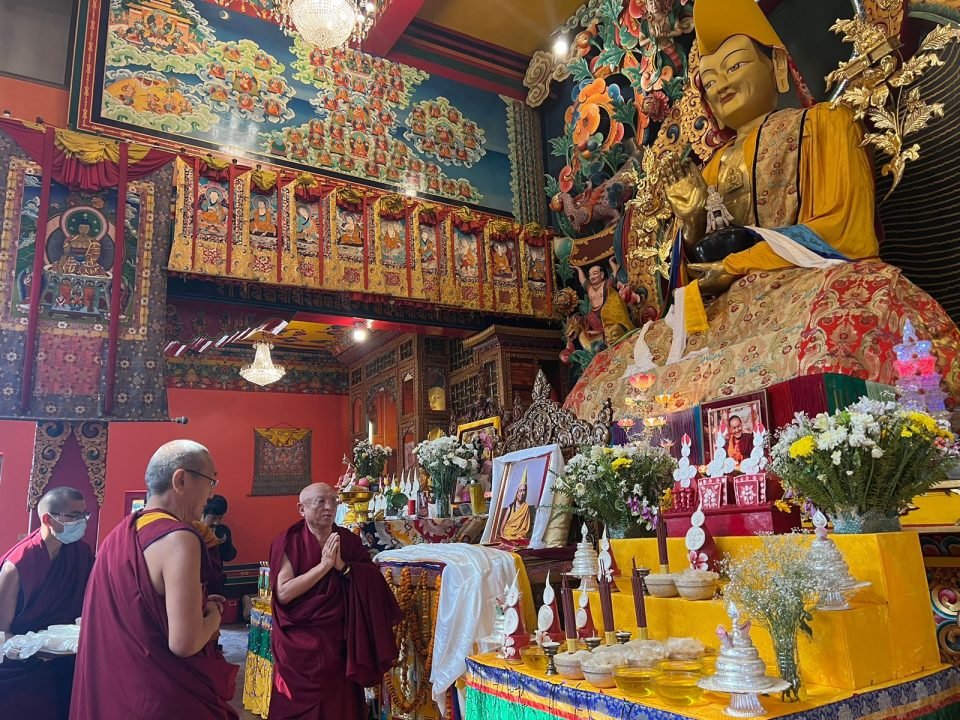
Khenrinpoche Thubten Chonyi and Chokyi Nyima Rinpoche at Kopan Monastery amidst the continual offering of prayers for Lama Zopa Rinpoche’s swift return. April 18, 2023. Photo by Kopan Monastery School.
Yesterday, the fourth week, was no exception. The Namgyal abbot, Thamtog Rinpoche flew from Dharamsala along with accompanying students to offer prayers at Rinpoche’s holy body and sponsor the full day’s puja. Thamtog Rinpoche was a childhood friend of our own precious lama since they were both disciples of Geshe Rabten at a young age. Rinpoche recalled knowing Lama Yeshe, Rinpoche, and Lama Lhundrup well at Buxa and watching as they traveled extensively spreading the pure teachings of the Buddha and especially of Lama Tsongkhapa all around the world. Rinpoche and Thamtog Rinpoche were close friends and during the puja Thamtog Rinpoche offered consolation to all of us grieving disciples with a moving speech in both Tibetan and English which brought many of us to tears.
Also at the puja yesterday was Serkong Dorje Chang Rinpoche who had flown back from a Wesak teaching event in Pokhara in time to attend. And Tsoknyi Rinpoche, another great lama friend of Rinpoche’s came to Kopan with some Tsoknyi nuns to offer prayers at Rinpoche’s holy body and make offerings to the disciples. As we sat in the puja in the main gompa below, we could hear the beautiful chanting of the Tsoknyi nuns in Rinpoche’s apartment above. How can we ever express enough gratitude to these lamas who show kindness and support to us at this time when we need it most?
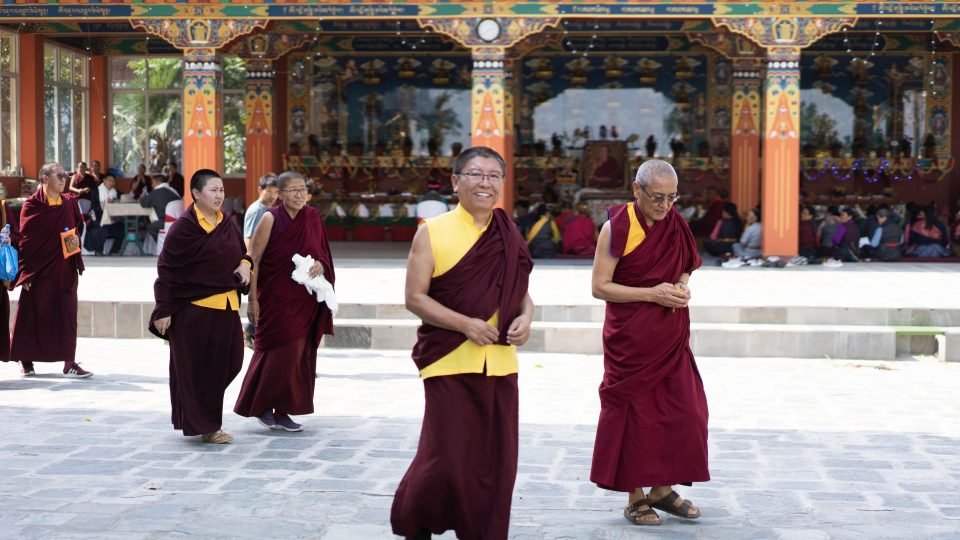
Tsoknyi Rinpoche with Khen Rinpoche Geshe Chonyi, Kopan Monastery, May 10, 2023. Photo by Ven. Lobsang Sherab.
It’s impossible to list here all the visitors high and low, famous and unknown, realized and devoted, local and from distant lands, who have come to visit Rinpoche over the past month, pay respects and offer support to the sangha. And it’s impossible to express enough gratitude.
These next three weeks will see an increased influx of visitors to Kopan as students arrive from around the world to pay respects to Rinpoche before traveling to Dharamsala to offer the long life puja to His Holiness Dalai Lama on May 24. This long life puja was Rinpoche’s holy wish and we can fulfil it. After that, the final days of May will see the culmination of the 49 days of pujas and prayers made with strong longing for Rinpoche to swiftly return.
At this time of heightened awareness of impermanence, Khadro-la advised us from the beginning to focus on bodhicitta, to pray to the Guru and to commit ourselves to fulfilling Rinpoche’s holy wishes. As the lamas are showing us—this is a time to honor Rinpoche’s inexpressible qualities and to support each other with kindness.
May 15, 2023: Serving Sentient Beings Is Serving Rinpoche
It’s Saturday night up at Rinpoche’s apartment and there are 30 plus nuns, monks and lay people on the finishing stretches of a four-hour Vajrayogini self-initiation. Some of the participants come night after night without fail, others are visitors or come when they have time. Outside the sky is clear and the lights of Kathmandu Valley twinkle like earthly stars. Inside the little porch area at the back of the main room— where Rinpoche used to take meals, entertain guests and do prayers and pujas—are a few Western nuns seated around the mandala house. There is no more space in the room where Rinpoche’s holy body is located, numbers have to be restricted due to the limited space—but somehow everyone gets accommodated. The wish to participate in these prayers at this special time in this special place is in everyone’s hearts.
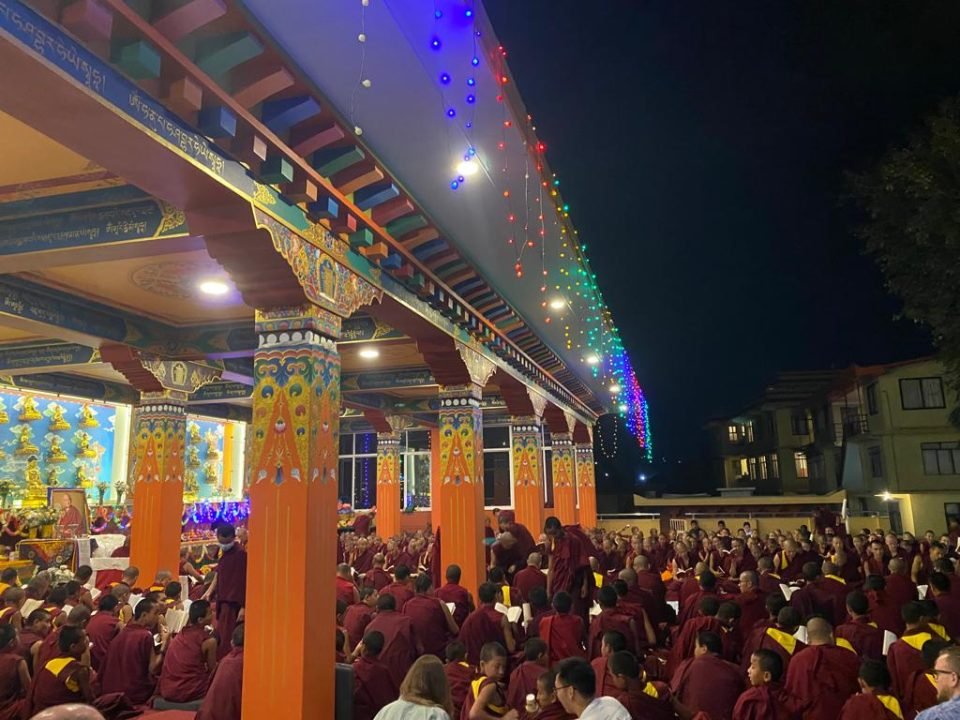
Prayers around the clock at Kopan Monastery for Lama Zopa Rinpoche’s swift return. Photo by Alison Murdoch.
It’s close to midnight when Rinpoche’s attendant comes with a tray to clear away our empty cups. About an hour earlier we were offered a selection of drinks, including a sweet and strong milky tea to keep us all awake, and an hour before that they served warm porridge. In between, money offerings were distributed to those doing prayers.
This is how it is up in Rinpoche’s apartment and how it has been 24 hours a day for the last 30 plus days. Pujas are scheduled continually thoughout the day and night, with short breaks for vacuuming, cleaning up and tending to the offerings, and longer breaks every few days to change the salt or rearrange furnishings. It hasn’t stopped. Hundreds of monks and nuns do prayers and pujas and self-initiations at Rinpoche’s holy body from dawn to dusk and dusk to dawn, usually joined by lay disciples who are resident at Kopan or visiting for the day. Sometimes there are several pujas going on at the same time when high lamas or visiting sangha from other temples gather for prayers in Rinpoche’s living room—the VIP space—whilst the regular schedule continues next door. And all the time a stream of visitors pass through the sacred space to circumambulate Rinpoche’s holy body in its magnificent mandala house, touch their heads to his throne, offer a khata and maybe an envelope, fruit, food, flowers or other gifts, and then file back out again collecting a packet of the salt that has touched Rinpoche’s holy body during the embalming process, some blessed torma and their choice of photo of Rinpoche on the way as holy souvenirs. Nobody leaves empty handed.
All these visitors are offered drinks and snacks by the helper nuns downstairs in the debate courtyard as they arrive. And all the participants at the pujas upstairs are offered a variety of drinks depending on the time of day—hot or cold water, sweet or butter tea, juice—along with snacks and money offerings. It’s an enormous amount of work, requiring nonstop coordination and well-calculated logistics.
Rinpoche’s small kitchen—originally built to cater for Rinpoche, a small entourage and guests—has now been transformed to cope with the huge influx of sentient beings that need to be continuously catered for; and the recently constructed lift up to Rinpoche’s room is now transporting visitors unable to manage the stairs and an endless supply of provisions for the visitors.
I ask the young monk on the night shift at Rinpoche’s apartment how many people pass through daily to pay respects to Rinpoche and he tells me that things have calmed down now to around 50/60 but in the early days it was hundreds and thousands each day for days at a time. Like all mature Kopan monks and nuns he has been offering service since the beginning in addition to his normal schedule of study. He’s enrolled at the Kopan tantric college and not yet 20, but I can see from his appearance that he is kind, patient, responsible and a good human being. He also speaks English well.
This is how it has been at Kopan since Rinpoche went into meditation. So much work, so many things to to be done, so much to be organized. Rinpoche has kept everyone busy with very little time to pause and be sad. There were pujas to be done, high lamas and visitors to be cared for, guests arriving and also a long life puja to be organized for His Holiness the Dalai Lama—in itself an enormous undertaking! Can you imagine?
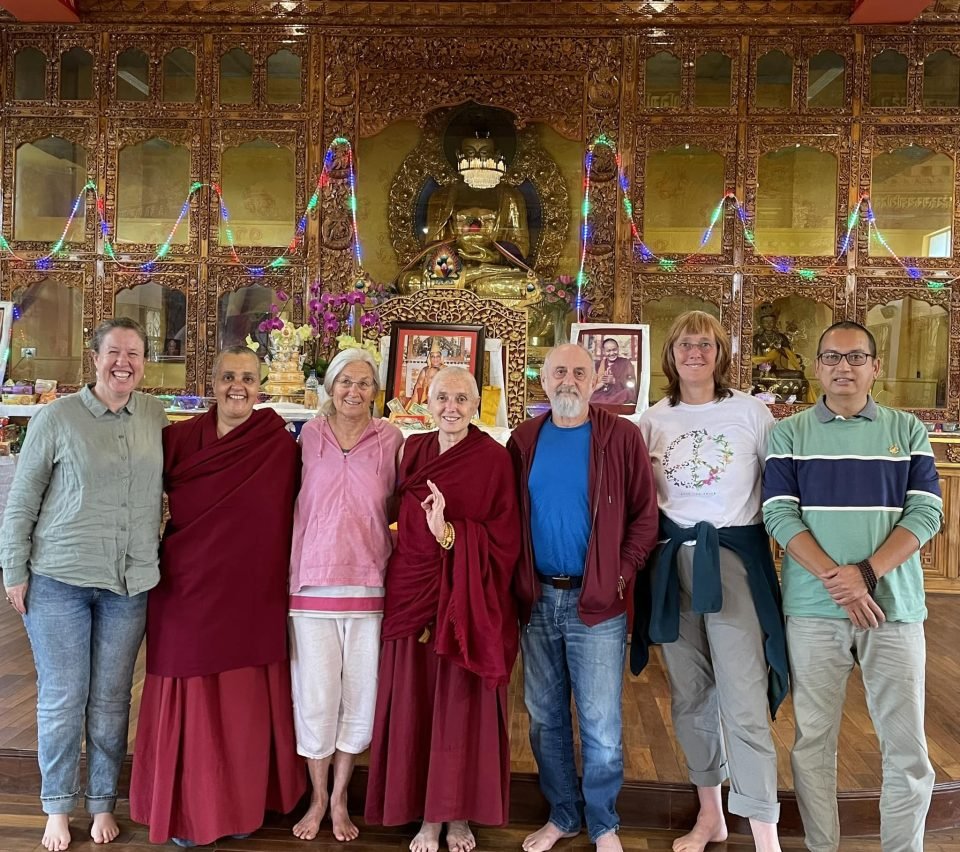
Lisa Gray, Ven. Namdrol, Paula Chichester, Ven. Sarah Thresher, Nick Ribush, Alison Murdoch, Sushil Grg; Dharma friends following prayers for Lama Zopa Rinpoche’s swift return, May 18, 2023. Photo courtesy of Ven. Sarah Thresher.
Pujas require drinks, food for the participants, torma, offerings, monetary distributions (which means piles of cash notes in Nepal!), texts and on and on. Truckloads of supplies have wound their way up the Kopan road every day and, during the most intense period, a caterer had to be brought in to provide the meals. Every visitor must be cared for. It was not just the Kopan monks and nuns doing prayers, but also sangha and lay people from all over the valley, all over Nepal, India and the world—as overseas visitors flew in from South East Asia, Mongolia, Australia, New Zealand, the Americas, and Europe.
It’s now past midnight and the Vajrayogini puja has come to a close. Outside, a group of young monks is waiting patiently for us to leave so they can begin their two-hour prayer session. Everything is well timed. Before they can enter the room it must be cleaned again and I watch as another of Rinpoche’s attendants vacuums up and down for the umpteenth time today to prepare it. Nearly 12 hours earlier I saw the same attendant at the Chenrezig puja—chanting, offering tsog, showing visitors around the mandala house and directing them take packs of holy salt and a photo as they left the room.
Watching all of this unfold over the past days and weeks, I’m reminded how Rinpoche would always teach that serving sentient beings is the best offering to all the Buddhas. All this service, all this devotion, all this sacrifice—I think Rinpoche would be very happy with how his monks and nuns have stepped up and taken responsibility. Yes there is sorrow and heart-break, yes there are times when the emotions are overwhelming and tears flow, but the work has to continue. That is what Rinpoche would want. And as we pray for Rinpoche to return, serving others is how we embody his teachings and keep them alive.
Ven. Sarah Thresher is an English nun who graduated in 1982 and met the Dharma in Kopan shortly afterwards—taking refuge with Lama Thubten Yeshe. She worked many years as an editor for Wisdom Publications and Lama Yeshe Wisdom Archive and has also taught at centers around the world. She ordained with His Holiness Dalai Lama in 1986. For the past five years she has been living in different locations in Nepal.
- Tagged: kopan monastery, ven. sarah thresher
- Home
- News/Media
- Study & Practice
- About FPMT Education Services
- Latest News
- Programs
- New to Buddhism?
- Buddhist Mind Science: Activating Your Potential
- Heart Advice for Death and Dying
- Discovering Buddhism
- Living in the Path
- Exploring Buddhism
- FPMT Basic Program
- FPMT Masters Program
- FPMT In-Depth Meditation Training
- Maitripa College
- Lotsawa Rinchen Zangpo Translator Program
- Universal Education for Compassion & Wisdom
- Online Learning Center
- Prayers & Practice Materials
- Overview of Prayers & Practices
- Full Catalogue of Prayers & Practice Materials
- Explore Popular Topics
- Benefiting Animals
- Chenrezig Resources
- Death & Dying Resources
- Lama Chopa (Guru Puja)
- Lama Zopa Rinpoche: Compendium of Precious Instructions
- Lama Zopa Rinpoche: Life Practice Advice
- Lama Zopa Rinpoche Practice Series
- Lamrim Resources
- Mantras
- Prayer Book Updates
- Purification Practices
- Sutras
- Thought Transformation (Lojong)
- Audio Materials
- Dharma Dates – Tibetan Calendar
- Translation Services
- Publishing Services
- Teachings and Advice
- Find Teachings and Advice
- Lama Zopa Rinpoche Advice Page
- Lama Zopa Rinpoche: Compendium of Precious Instructions
- Lama Zopa Rinpoche Video Teachings
- ༧སྐྱབས་རྗེ་བཟོད་པ་རིན་པོ་ཆེ་མཆོག་ནས་སྩལ་བའི་བཀའ་སློབ་བརྙན་འཕྲིན།
- Podcasts
- Lama Yeshe Wisdom Archive
- Buddhism FAQ
- Dharma for Young People
- Resources on Holy Objects
- Ways to Offer Support
- Centers
- Affiliates Area
- Teachers
- Projects
- Charitable Projects
- Make a Donation
- Applying for Grants
- News about Projects
- Other Projects within FPMT
- Support International Office
- Projects Photo Galleries
- Give Where Most Needed
- FPMT
- Shop
Translate*
*powered by Google TranslateTranslation of pages on fpmt.org is performed by Google Translate, a third party service which FPMT has no control over. The service provides automated computer translations that are only an approximation of the websites' original content. The translations should not be considered exact and only used as a rough guide.For happiness, cherish others.







